Midway class
 USA – Fleet Aircraft Carriers (1945-92):
USA – Fleet Aircraft Carriers (1945-92):
USS Midway, Franklin D. Roosevelt, Coral Sea
Cold War USN Carriers:
Essex SBC-27 class | Saipan class CVs (1945) | Midway class | USS United States | Forrestal class | Kitty Hawk class | USS Enterprise | Nimitz class | Gerald Ford classAssault Carriers:
Iwo Jima class | Tarawa class | Wasp class | America class | SCS class | VSS classThe first USN armoured aircraft carriers
The Midway class aircraft carriers were the penultimate evolution of interwar and WW2 US aircraft carrier design: They were designed at the same time as the future Essex class fleet carriers in 1940, but proceeded from a parallel design branch based on the proposal of a fully armoured carrier: USS Midway was the lead ship of a class of six laid down in 1943 (CV-41, 42) and 1944 (CV-43) while the rest were cancelled before being ordered.
USS Midway was commissioned 10 September 1945, as the war was already over since 15 August, with Japan surrendering in 1st September onboard USS Missouri. So no, they did not see action in WW2. Yet, they are seen in the WW2 due to their design started at the very start of it, and went all along.
Fortunately, all three were large enough to operate the new generation of jets of the 1950s, and proved to be the bedrock of the US Navy during the Korean war. Modernized extensively several times, they served also in Vietnam and even took part in the 1991 Gulf War, being the oldest active aircraft carriers of the USN at the time.
Design Development of the CVB-41-class
Essentially, the yet unnamed design started as an alternative to the Essex class design itself, the major wartime fleet CV class. Debates about how much armor was to be placed on the deck and hangar led to a divide between those who wanted something more in the line of previous Yorktown class, just larger and better protected overall, and thos who wanted something in the like of the Illustrious class.
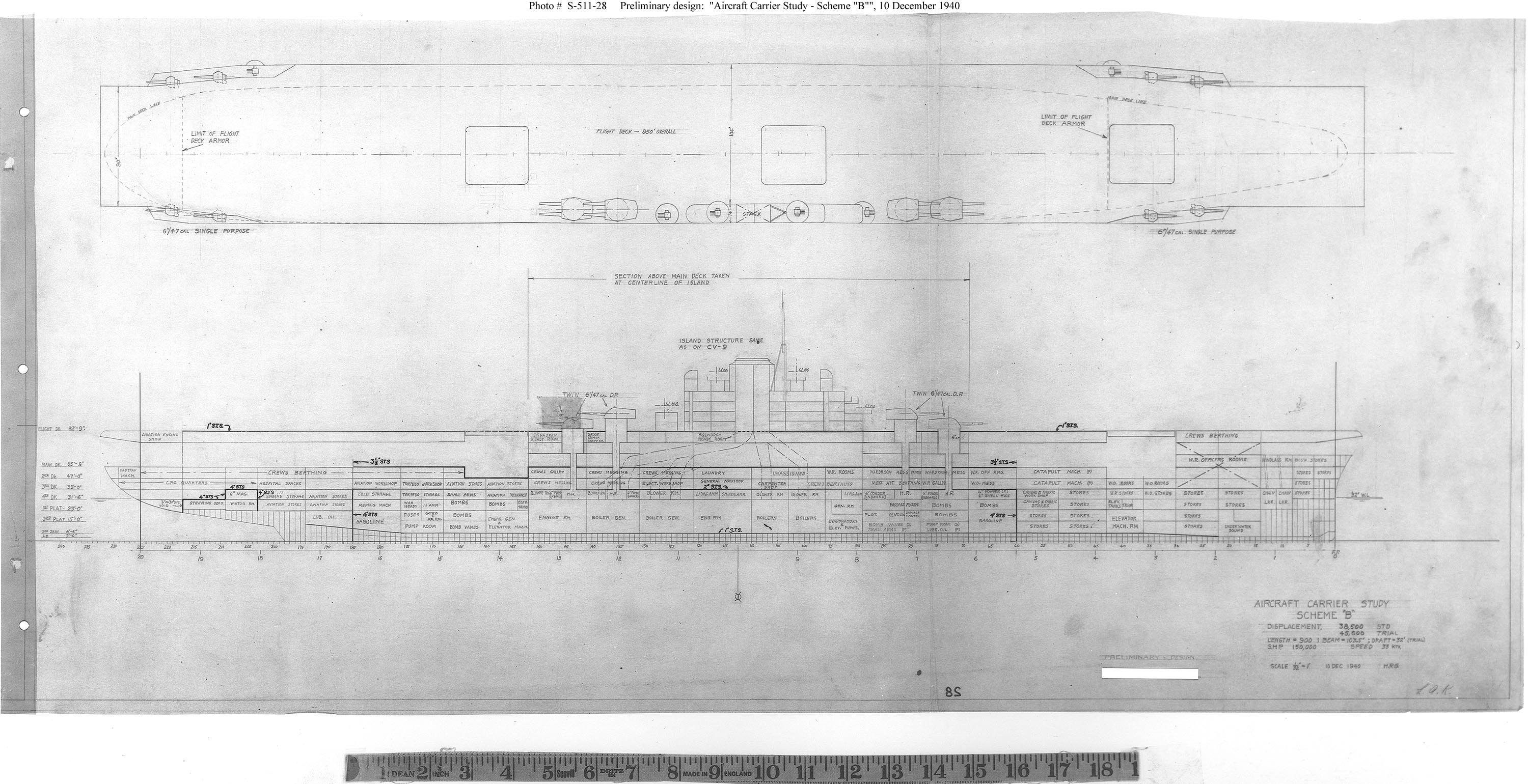
Design Study, scheme C, December 1940, alternative study of the Essex class with extensive armor, not retained for the final design. She had 3 in 1/2 of STS steel on the main armor deck/hangar floor and for her flight deck 1-1/2 in, but 4 in over avgas tanks, steering gear, ammo magazines, 2-1/2 inches roof, 4 inches bulkheads.
The Midway class proceeded from the alternative armored version of the Essex class emergency fleet carriers, not retained. The final Essex design approved in September 1941, with raduced armor starting at the hangar floor, and with a citadel below, but limited thickness. More than thirty were ordered, of which some were completed after the war.
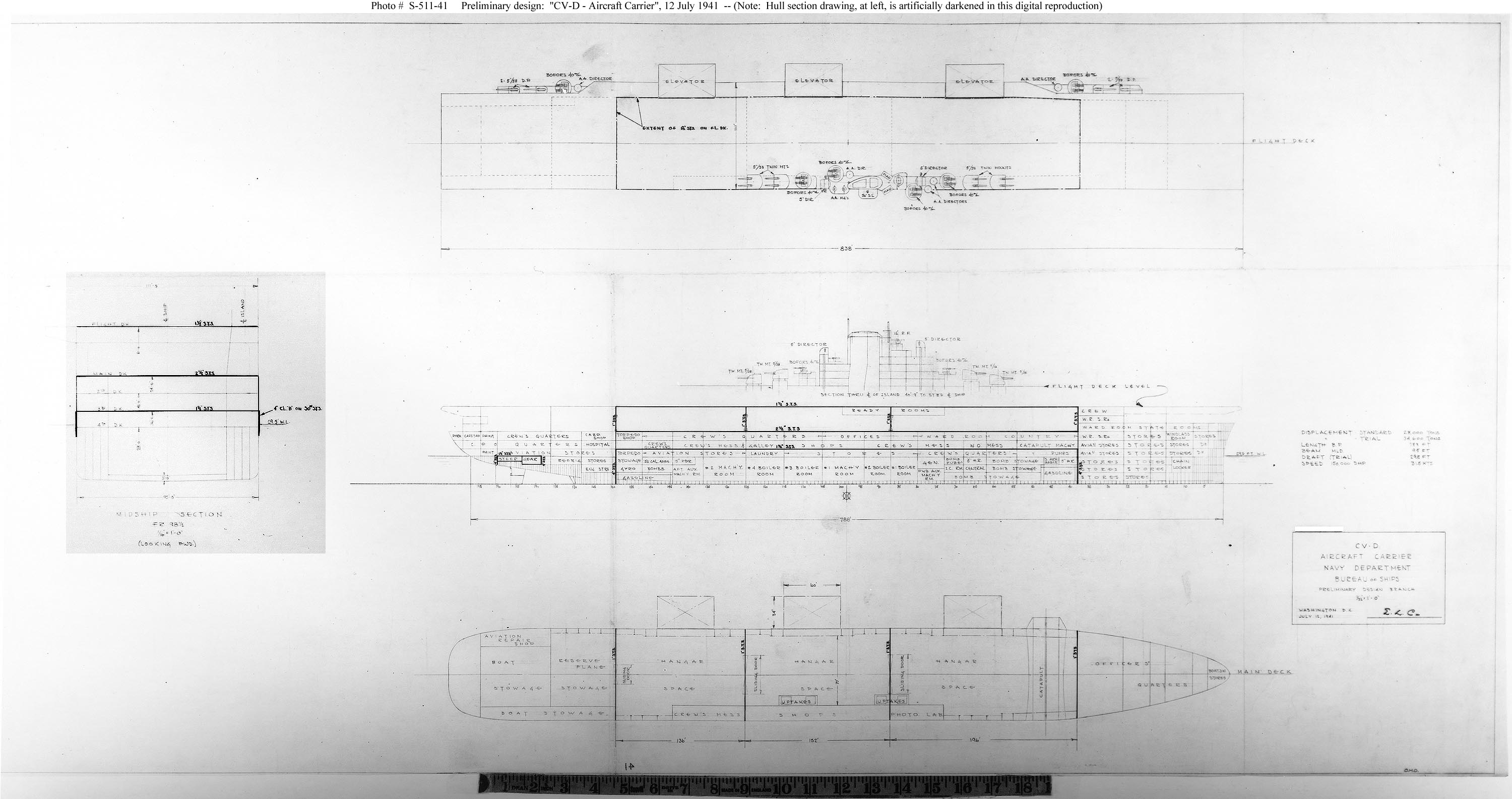
Design Study “CV-D Aircraft Carrier”, 12 July 1941, an alternative design with a fully armored hangar. It was not adopted.
This 1941 proposal was clearly inspired by the British Illustrious class, with a central “citadel” reduced to 1/2 of the total lenght, compartimentalized into three sub-sections and with three external lifts. Light armour overall with just 1-1/2 inches STS (flight deck), 1 inches (bulkheads & subdivisions), then 2-1/2 in for the hangar floor, 1-1/2 inches for citadel roof (armoured deck below), but 4 inches bulkheads). The hangar was mostly protected, but not entirely, leaving some extra parked planes exposed.
It was not retained for the Essex class as at the time, the full strenght of an air group, the famous “sunday punch” was estimated more important. The armoured hangar limited it a great deal. However some thought rightfully that by just making their aircraft carrier larger, the hangar itself would be larger, and thus, able to house the necessary air group.
The CVB-41-class, unnamed when studied, were an alternative design study provided with an armored flight deck on the size of an Essex class. Calculations showed the air group would have been down to 64 compared to 90 or even 100, so 1/3 of the Essex capacity. However it progressed through 1942, and became more heavily influenced by British wartime experience with their armored carriers.
As stated in the Bureau of Ships Navy Dept CV13 Damage Report:
❞
As a result of study of damage sustained by various British carriers prior to our entry into the war, two important departures from traditional U.S. Navy carrier design were incorporated in the CVB Class, then still under development. HMS Illustrious in an action off Malta on 1 January 1941 was hit by several bombs, three of which detonated in the hangar space. Large fires swept fore and aft among parked planes thereby demonstrating the desirability of attempting to confine the limits of such explosions and fires by structural sectionalization of the hangar space. On the CVB Class the hangar was therefore divided into five compartments separated by 40 and 50-pound Special Treatment Steel (STS) division bulkheads extending from the hangar deck to the flight deck, each fitted with a large door suitable for handling aircraft.
It is hoped that this sectionalization, in conjunction with sprinkler and fog foam systems, will effectively prevent fires from spreading throughout the hangar spaces, as occurred on USS Franklin on 30 October and 19 March. The damage experiences of several British carriers, which unlike our own were fitted with armored flight decks, demonstrated the effectiveness of such armor in shielding hangar spaces from GP bombs and vital spaces below the hangar deck from semi-armor-piercing (SAP) bombs. Accordingly, the CVB Class was designed with an armored flight deck consisting of 3-1/2-inch STS from frames 46 to 175 with a hangar deck consisting of two courses of 40-pound STS between frames 36 and 192. Although none of the CVB Class carriers were completed in time to take part in war operations, the effectiveness of armored flight decks against Kamikaze attacks was demonstrated by various carriers attached to the British Pacific Fleet.
The concept’s logic evolution was for a larger carrier to support a larger deck armor AND the required air group. Weight-savings to armor the flight deck were engineer’s nightmare though, due to metacentric hight (and thus, stability) concerns. It was achieved by removing the initially 8-inch (203 mm) battery around the island, and then having 5-inch single mounted in sponsons along, but under the flight deck. In US practice, the armored deck was not part of the ship structure and instead, engineers stuck to the “strength deck”, at hangar deck level while the armored flight deck was part of the superstructure. This design was unique and never followed. The following Forrestal-class supercarriers indeed needed a deeper hulled design to carry the strength deck at flight deck level, and this made for a both stronger, yet lighter hull.
Final Design
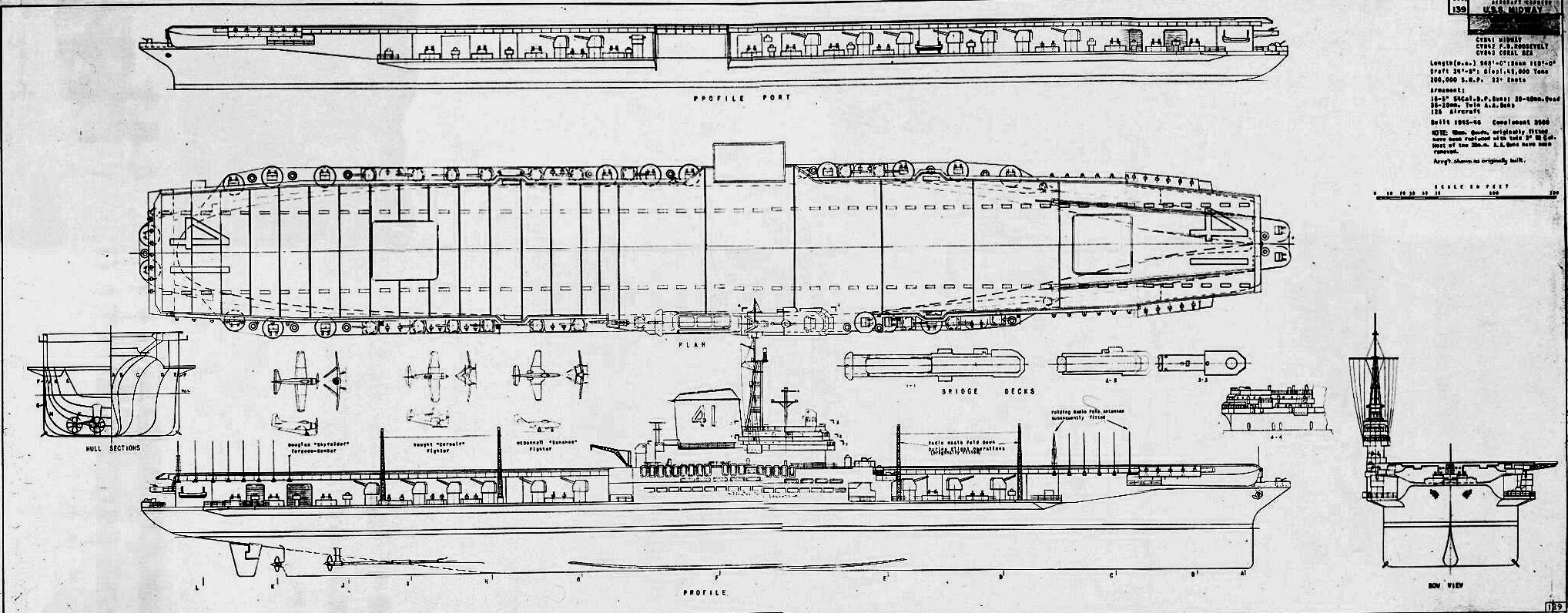
The Midway-class as designed were very large, already compared to the Essex class, and they displaced twice as much as a prewar Yorktown class. It could accommodate more planes despite its armoured fight deck, far more than any USN carrier, about 30% more so about 130 aircraft. Such air group reached the very limit of effective command and control, just for one ship. This enormous size however proved to be a blessing in the upcoming years, as the number of aircraft was drastically reduced whereas they could more easily accommodate larger and faster aircraft of the jet age, something the Essex class struggled to do during the post-WW2 service.
While having an excellent protection and massive airwing they still were criticized for some shortcomings:
-They were cramped internally and crowded.
-Their Freeboard was unusually low and in heavy seas, they were easily flooded
-The latter problem was solved by fitting them with a fully enclosed hurricane bow (SCB-110/110A upgrades)
-Also in easy weather, they “corkscrewed” so much it precluded any landing operations.
Lessons were learned to rework the following-up Forrestal-class which had a deeper hull, with more freeboard and better seakeeping, and the required enclosed bow as well.
-Their beam was beyond the Panama Canal’s gates max size, hampering their operational life for rapid redeployments.
Naming Policy
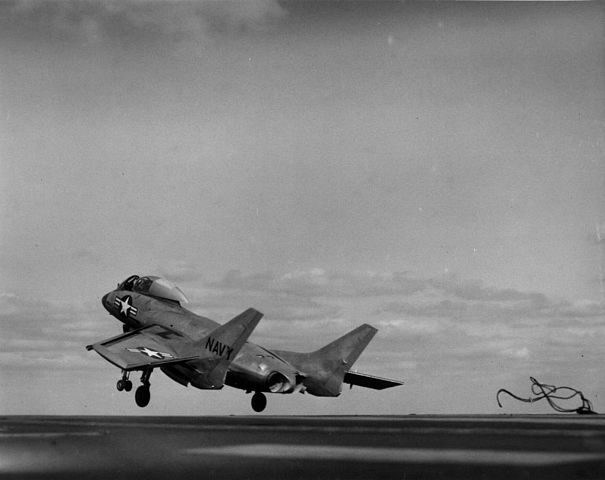
Launch of USS Midway November 1952
Like many aircraft carriers of WW2 they were to be named after famous battles. “Midway” and “Coral Sea” were obvious choices for the first two, with CV-43 possibly named “Santa Cruz”, but as the second was being completed, president Franklin D. Roosevelt passed out. CV-42 Coral Sea was renamed in his honour an the third inherited her former name. Thus, it introduced a precedent in naming carriers after presidents, something which became prevalent from the much later Nimitz class. For the last ones, “USS Leyte Gulf”, “USS Phillipines Sea”, “Samar”, “Surigao strait”, “Cape Esperance” and many others are everyone’s guess.
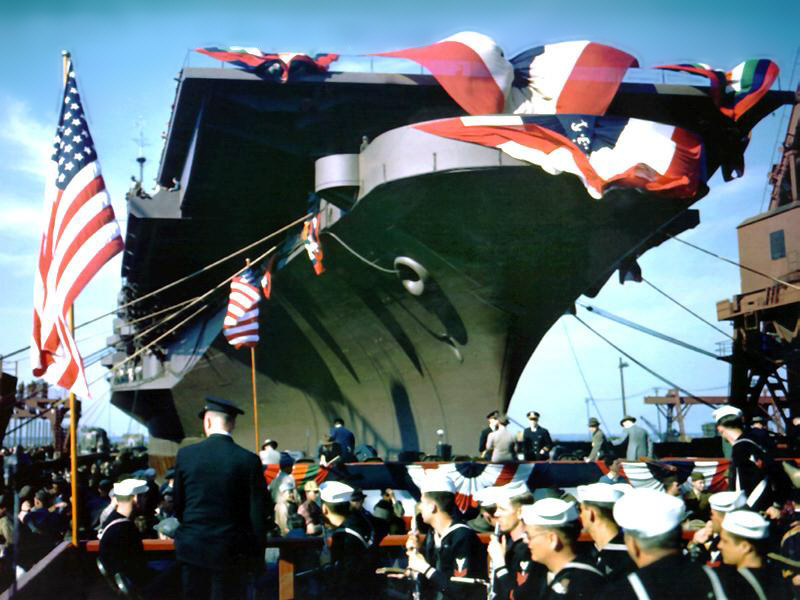
USS Midway (CVB-41), prepared for christening ceremony.
Construction
USS Midway (CV-41, later CVB-41 and CVA-41) was laid down at Newport News Shipbuilding and Dockyard Co. on 27 October 1943, launched 20 March 1945 and race-completed on 10 September 1945. She was the only one preserved.
USS Franklin D. Roosevelt was the former USS Coral Sea (CV-42, later CVB-42 and eventually CVA-42), laid down at New York Naval Shipyard, New York City on 1 December 1943, launched 29 April 1945 and completed on 27 October 1945. She was the first to go, not modernized fully and decommissioned on 30 September 1977, roken up at Kearny, 1978.
USS Coral Sea was at first unnamed, and earned in turn the previous name for CV-42.
She was CV-43 and CVB-43 and then CVA-43. Laid down on 10 July 1944 at Newport News Shipbuilding and Dockyard Co. like USS Midway, but launched much later on 2 April 1946 and completed 1 October 1947 so in 19 months, versus seven months for USS Midway. The long delay was due to all wartime emergency setups being dropped and construction standard falling under the standard peacetime contigencies. A few modifications were made also as the result of wartime lessons. “CVB” meant “Large carrier”, a new denomination to distinguish them from the standard “CV” fleet carriers.
Hull
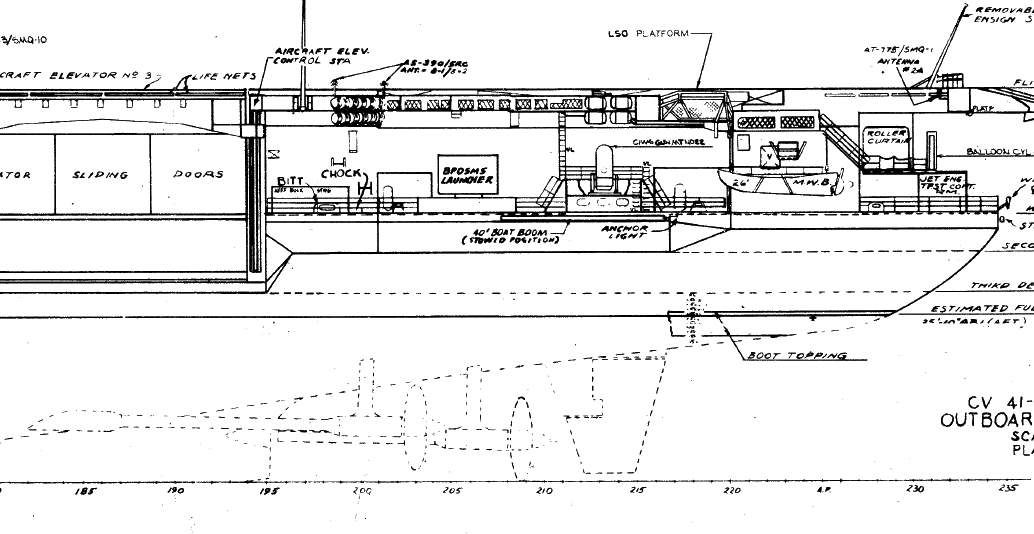
For construction, more extensive use of electric arc-welding was used throughout, help saving 10% compared to riveted assembly. Compared to the previous Essex, they measured 901 ft or 274.3m long at the waterline and or 968 feets 295 m overall. This was quite an increase over the Essex, even for the late “long bow” type (888 ft or 270.7 m oa). Their waterline beam was quite larger, at 121 feet (37 m) versus 93 ft (28.3 m) wl, making them unable to cross the Panama canal. Sme for their draft at 33 ft (10 m) fully loaded, versus 23 ft (7.0 m) standard and 27.5 ft (8.4 m) fully loaded on the Essex. From her keel to the top of her mast she measured 222′ 3″ (68 meters).
The total height from the waterline to the deck was no greater however, which came back as a criticism later. Midway was completed with a classic bow, with a separation from the flight deck, shorter, and tippied by a quad Bofors 40 mm. But the design was revised to included a “storm bow”, for the next FDR and Coral Sea, fully enclosed. This was the result of wartime experience and a successful feature adopted by rebuilt carriers and new ones alike.
Powerplant & Performances
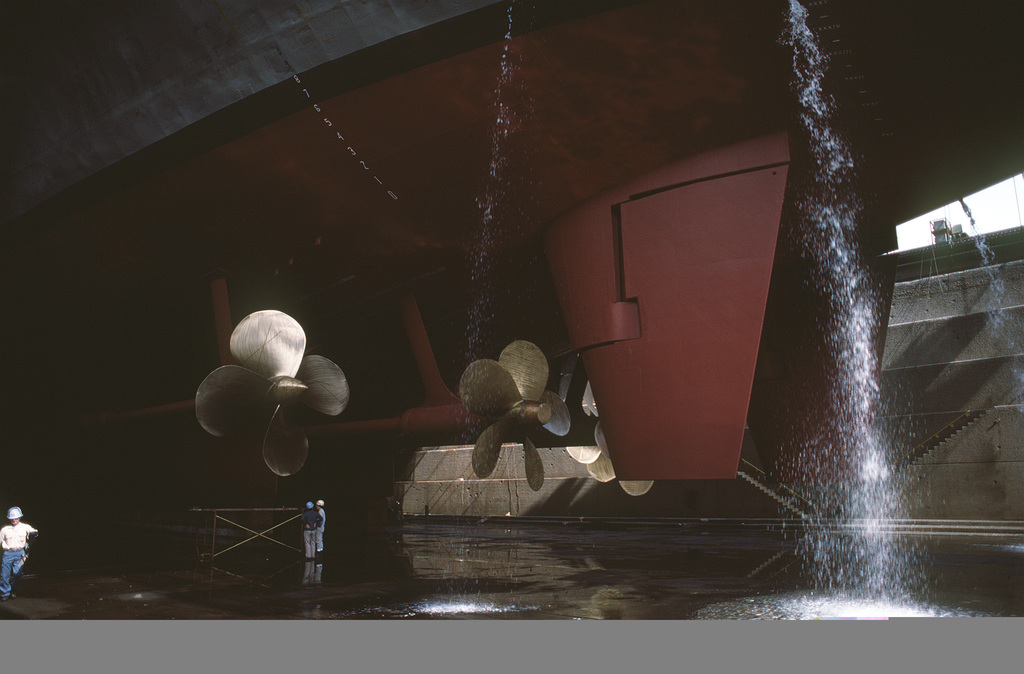
The installation of these latest carriers was to be of course scaled up to take in account the same fleet speed requirements indexed to a much larger displacements, dimensions and armour. For this, one of the most extensive unit even installed on a carrier was chosen: It consisted in four shafts, with larger propellers than the Essex’s, approx. 18 feets (5.4 meters) in diameter and 44,000 pounds (22 tons). They were mated on four corresponding Westinghouse Steam turbines, which, like the previous ships were divided between cruise, inner low-pressure ones, and top speed, outer, high-pressure ones.
The major difference was that the Midway class turbines were fed by steam coming from not eight, but twelve Babcock & Wilcox boilers working at 565 psi and 850°F (450°C). This was 1/3 increase, resulting logically in a total output reaching 212,000 shp (158,000 kW) versus 150,000 shp, on the Essex-class. In fact, the output increase, thanks to improvements in the turbines and boilers, out-reached the steam increase by some margin, showin the progresses made there. According to this, the Midway class were able to reach still their designed fleet speed of 33 knots (61 km/h; 38 mph).
This top speed however was only reached by USS Midway in 1945. In reality, her sister ships FDR and Coral Sea were modified in between, heavier and as a consequence a bit slower. With the SBC-110/110A upgrade, it fell to 30.6 kts, but after the SCB-101.66 modernization and some optimisations, it reached 31.6 knots again. For comparison, the next Forrestal class, heavier, went for an even larger powerplant, with no less than 8 Steam turbines and new sets of boilers, for 280,000 shp (210,000 kW) and 34 knots, almost unchanged on the 32 kts Kitty Hawks.
Range was conditioned by their fuel capacity, which varied from 6,003 tons in peacetime and 10,032 tons in wartime “filling every void onboard”. This enabled a total reach of 15,000 (15) nautical miles, to compared with the Essex’s 15,440 and around 12,000 for the next classes. After the SBC modernizations, this range fell to 12,500 at 20 kts for CVA41 and 42, and 9,500 at the same speed for CVA43. Like the previous Essex, and even more so, they bleed speed when hard to port or starboard, loosing more than 60% speed due to their larger hull and draft. They also had a larger turning radius despite their pair of larger rudders. However they were stable, good seaboat and good take-off platforms.
Armour & Overall Protection
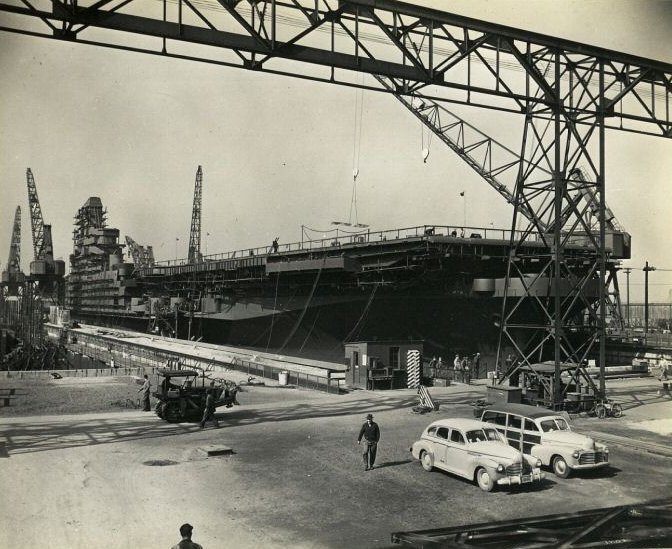
The experiences of several British carriers, which unlike our own were fitted with armored flight decks, demonstrated the effectiveness of such armor in shielding hangar spaces from GP bombs and vital spaces below the hangar deck from SAP bombs.
*USS Franklin War Damage Report
Probably the most important part of the design, protection was essentially driven from the alternative, rejected Essex class fully armored version. In 1940, bomb manufacturer promised new 1,750lb models able to defeat 7in of deck armour. For engineers however, it was out of question to put an armored deck 8-in thick for obvious stability reasons, not even for the hangar deck, but a compromise was found, with a 3-layered defence, the strongest yet for any US aircraft carrier. The belt was asymetric, and the hangar was enclosed in thick bulkheads. It was designed to face marauding Japanese 8in cruisers. It should be added thee were more transverse bulkheads (26 in all) and much more subdivided compartments than any other carrier class. Yet, these figures were the best of any allied CV during WW2, greater than the 4.5 in (114 mm) at best for the Illustrous.
- Flight Deck between the two lifts: 3.5 in armour plate (88 mm)
- Hangar Deck was of 2 in STS (51 mm)
- Third Deck (hangar floor) 2 in STS
- Port side armoured belt 7.6 in (193 mm)
- Starboard side belt 7 in (178 mm)*
- Bulkheads 6.2 in (160 mm)
*The difference in thickness was to counterbalance the weight of the island.
The Midway class had a well subdivided arrangement of the machinery spaces underwater, a simple copy-paste of the Montana-class battleship system, more evolved than the Iowa class. Instead of eight main engineering compartments, the Midway-class had 26 in total, with no less than twelve boiler rooms off the centerline, four widely separated engine rooms. This ensure the least risk of a critical flooding, even if hit by several torpedoes. However the downside of these subdivisions meant the class a reputation of being uncomfortable for their crews.
Interestingly enough, USS Midway was the only one completed with an armoured pilot house the bridge. However in 1945, the good old Conning Tower was seen as an hinderance and removed from the latest designs. USS Coral Sea none, sparing weight and stability enough to add the forward 5in Mk37 Fire Control System director relocated on top of the island. It was in front of the bridge for CVB-41 and this cleared further deck space.
It should be also noted that the heavy, armored flight deck needed to be strenghtened in order to prevent the ship from “racking”, deforming due to the stresses of her movements. The high metacentric height also produced excessive heel in hard rudder turns. One of the consequences of engineers trying to reduce top weight was the hull was relatively slim and low, causing pitch and roll heavy seas, and plunging in even moderate seas. In serious weather, it was more diffisult to operate aviation. Although efforts has been put for stability of the CVBs the low freeboard had them reputed “wet” for their entire careers.
Armament
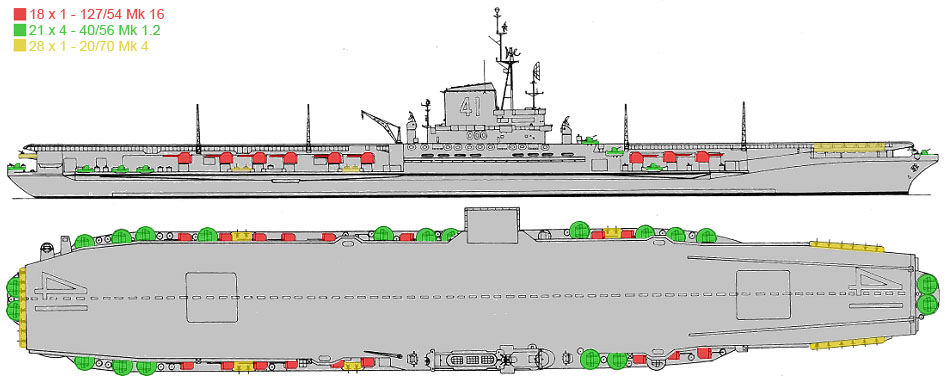
It was quite different than the previous Essex class. The debate over the CVB’s gun armament was indeed intense in 1941 as some argued that perhaps dual-purpose mounts were insufficient, and assessed the need ito answer the threat of powerful, 8-in Japanese cruisers, still justifying a return to heavier artillery, still on blueprints at that stage. Eventually, in 1942, it was decided to free deck space and cound on the Task Force buffer, radars and air patrols to spot and deal with any cruiser. In 1943, AA defence was back as the main priority.
Instead of repeating the four dual standard 5-in/38 on deck either side of the island, as they constituted an obstacle to aricraft operation on deck, and a further wind trap, it was decided to move the entire armament on sponsons under the flight deck, but to move on a new type, the newly tested 5in DP gun (5”/54). The rest was a classic combination of the usual quad 40 mm Bofors which due to the larger hull, topped at 21 mounts, and the usual 20 mm Oerlikons, down to 28 as it was understood at the latter stages of the war nothing beats the Bofors for close AA defense.
CVB43 actually had “only” fourteen single 127mm/54 Mk 39 and nineteen quad 40mm/60 Mk 2 and no 20 mm at all. The armament was considerably revised during the SBC-110 upgrades and their following iterations.
Main artillery
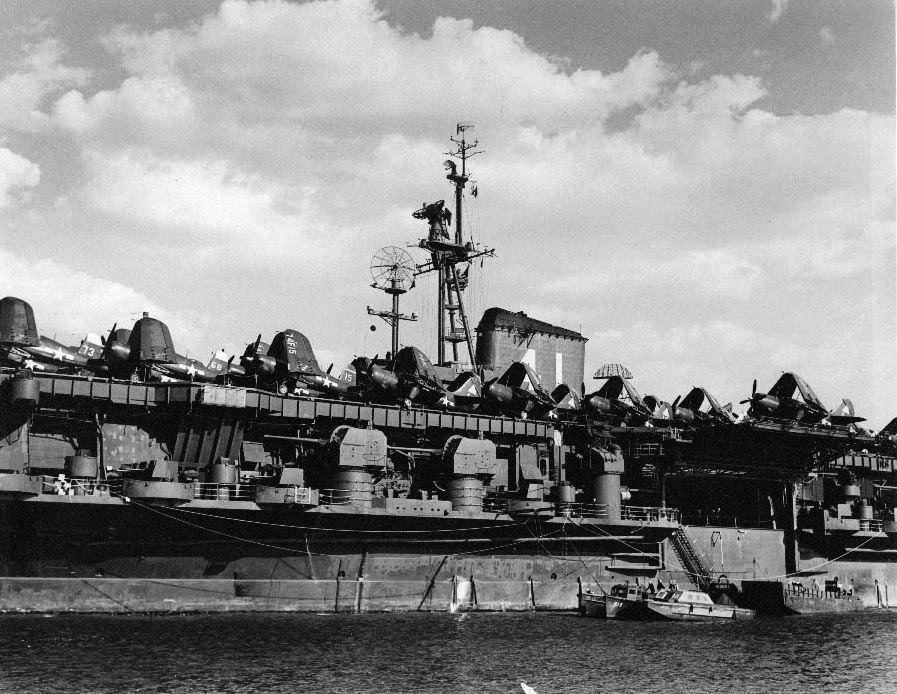
This was constituted by a brand new battery of single eighteen turreted 5 in (127 mm)/54 caliber guns. They were positioned on either sponsons, three forward, six aft or nine on either side. They rested on semi-automated loading casemates. However, they were less popular as the previous Mark 12, due to the larger and heavier projectiles and cartridge cases, to be manned by the crew.
Designed in 1940 these were the designated successors of the standard 5-in/38 Mark 12 ubiquitous in the USN and planned for the Montana class BBs. The idea was improve their performances wholesale, between range and velocity (with a longer barrel, 54 versus 38), and higher rate of fire with more automation, including self-aiming assisted by radar.
However the development was long, and it only entered service in 1945, ready for the Midway class but also adopted by the rebuilt gunnery training ship USS Mississippi AG-128 (ex BB-41). More on navweaps
- Shell HC Mark 41 69.33 lbs (31.448 kgs), 26.0 in (66 cm)
- Mk 6 Cartridge 127 x 836 mm, 13.04 lbs. (5.91 kg)
- Muzzle Velocity 2,650 fps (808 mps)
- 500 rounds per gun
- AA ceiling 51,600 feet (15,728 m)
_c1964.jpg)
Anti-aircraft Battery
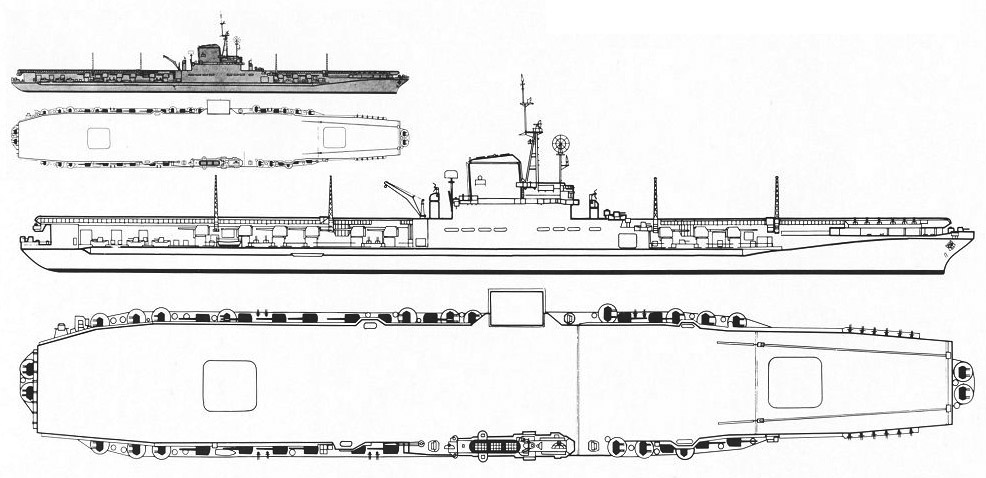
The 21 x 4 (quad mount) 40mm/56 Mk 1.2 battery was entirely made of quad mounts as it was judged a more effective concentration compared to twin mounts, which consumed more space. As shown by the overhead view, there were two at the bow and stern each, six aft, seven port and three starboard forward (84 barrels). All were crewed by 11 men, and came with their own radar fire control.
For the 20 mm guns, some sources states as many as 68 guns, but it’s probably at the 1943 or 1944 design stage. In 1945, Kamikaze attacks reports clearly stated that only the 40 mm was really efficient. To spare space and crew, it was probably decidded to curtail it down to just 28, the figure retained by most sources. They were posted where space could be found: Two small twin posts aft, port and starboard, a full gallery of eight at the landing deck lip, and two forward, port and starboard. Apart the island, the only “obstruction” on the flight deck starboard was a lone quad 40 mm mount, with a Mk37 Fire Control System director behind, making the CVBs, the cleanest fleet carriers so far. It seems however that after 1945, 10 twin 20mm mounts were fitted to Midway. Both the 40 mm and 20 mm were removed in the late 1950s and SBC-110 reconstructions.
Fire Control and Radars
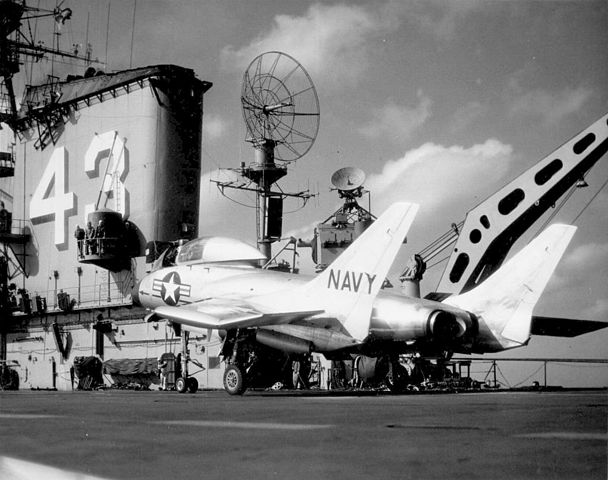
An F7U-3 on CVB-43 in November 1952. Behind it, an SK-2 is visible, as well as Mk37 gun director and its Mk25 radar
CVB41 and 43 (Midway and Coral Sea) had the SK-2 Air-search radar, SR-2 surface radar, SX radar and two SG navigational/surface search radar antennae, four Mk 25 fire control radars plus a TDY ECM suite. CVB42 (USS FD Roosevelt) had both the SR-2 and SR-3 radars SX, the rest was identical.
-The 3500 kW SK2 radar developed in 1945 was manufactured by General Electric. It worked in VHF band with a beamwidth of 10°, a pulsewidth of 5 μs, and range of 160.9 km (86.9 nmi), azimuth ± 3 °, at a precision of ± 100 yd. Externally, it was caracterized by a large, round parabolic antenna, with wide open work metal grating.
-The SR radar was small sized but longish antenna shaped as an inverted V, installed in older battleships, some arrangements with two antennas were known.
-The SX radar… (no info yet)
-The SG radar was a 1941 surface seach radar, with a wavelength of 10 cm, power output of 70 KW and range of 15.7 nm. Obsolete in 1945, it was small sized and used as navigational antenna as well.
-Mk 25 radar: Coupled with the standard Mk37 gun director.
-TDY ECM suite: No info
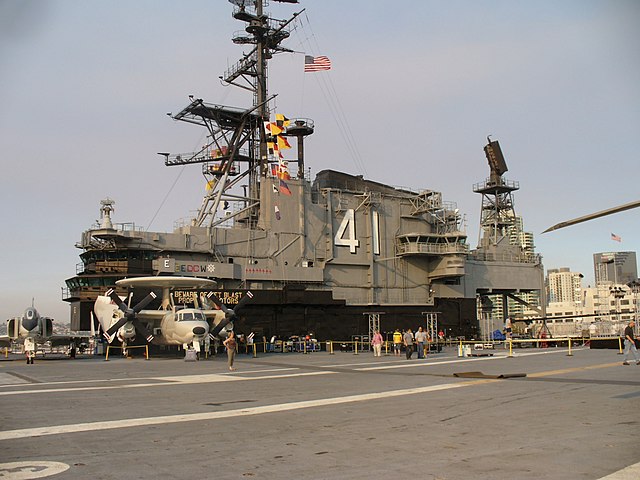
USS Midway’s tower.
Aviation facilities
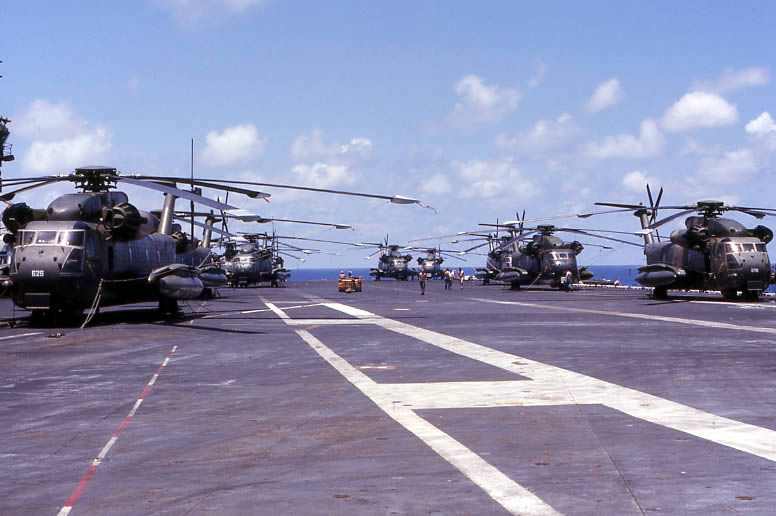
CH-53 helicopters on USS Midway, April 1975
Catapults
Although the 4.02 acres flight deck was straight, with a small overhang for the starboard island, there was plenty of room for the heaviest piston-powered planes in the US inventory which included even bi-motor models (see air group). It was still shorter than the total hull lenght, and she was originally designed with an axial flight deck, with an axial lift forward bringing attack planes to the two hydraulic powered catapults H4-1s catapults, longer than the previous models (just one on the Essex, while the hangar catapult was not repeated). They were tasked to propel a 28,000 lb (14 tons) aircraft for 0 to 90 mph (145 kph).
Flight deck arrestor cables and barricades
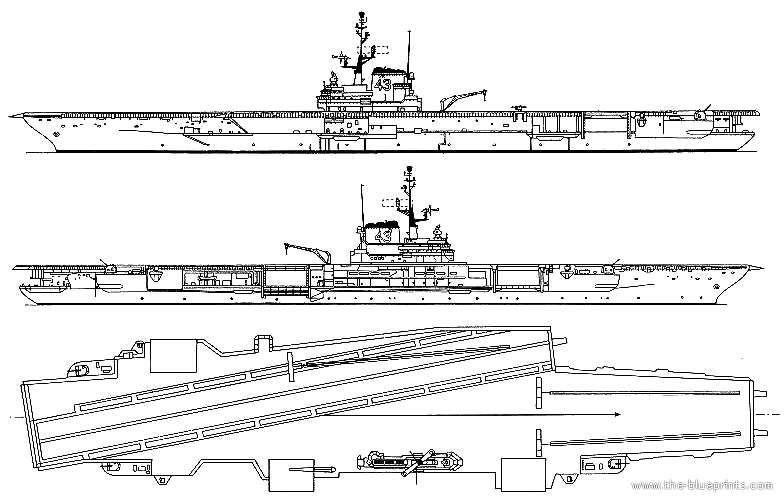
USS Coral Sea in 1960
The long landing deck aft allowed the heaviest models plenty of room to catch one of the seven main arrestor cables: Five aft the the second aft axial lift, one after it, and one last just before the flight deck catapult area. They were all fitted with each two winches, so fourteen Mk 5 Mod 0 engines. In case of a miss, there were six barricades across the centre of the flight deck.
Lifts
The forward flight deck was designed for launching 13-ton aircraft, the aft flight deck was designed for landing 11-ton aircraft, assuming in-flight expenditure of fuel and ordnance. The “clean” forward part of the island was also perfect to deal with variable wind-over-deck conditions.
The third lift was a smaller overhanging model located immediately opposite to the island, port. The main purpose of the flight deck in initial air operations was of course to launch it’s own “sunday punch” (see the Essex part about it). About 100 tightly parked aircraft were to be launched, bombers and TB bombers first and fighter last, due to their respective fuel consumption and range, although there were variations in this. This was the best way until 1945 to guarantee the rapid departure of a full air strike. In the case of USS Midway, the park reached 130, and they could all “on paper” fit on the flight deck. For command & control though, it was not that easy.
Another issue with the lifts was that speed was paramount, and due to this, elevator speed was a primary requirement, and they were made in aluminum, and therefore sensible to splinter damage and bomb hits.
After launching the strike, catapults were used to bring on deck and catapults the extra reserve fighters in the hangar used for the CAP (Combat Air Patrol). Thus, the landing deck was kept free to accept the rapid return of a plane with any technical problem, and later the return of the first wave, while the aft and centre-side lift were not used. To deal with floatplanes, a large flight-deck crane was used to haul them up to the flight deck.
Hangar and safety
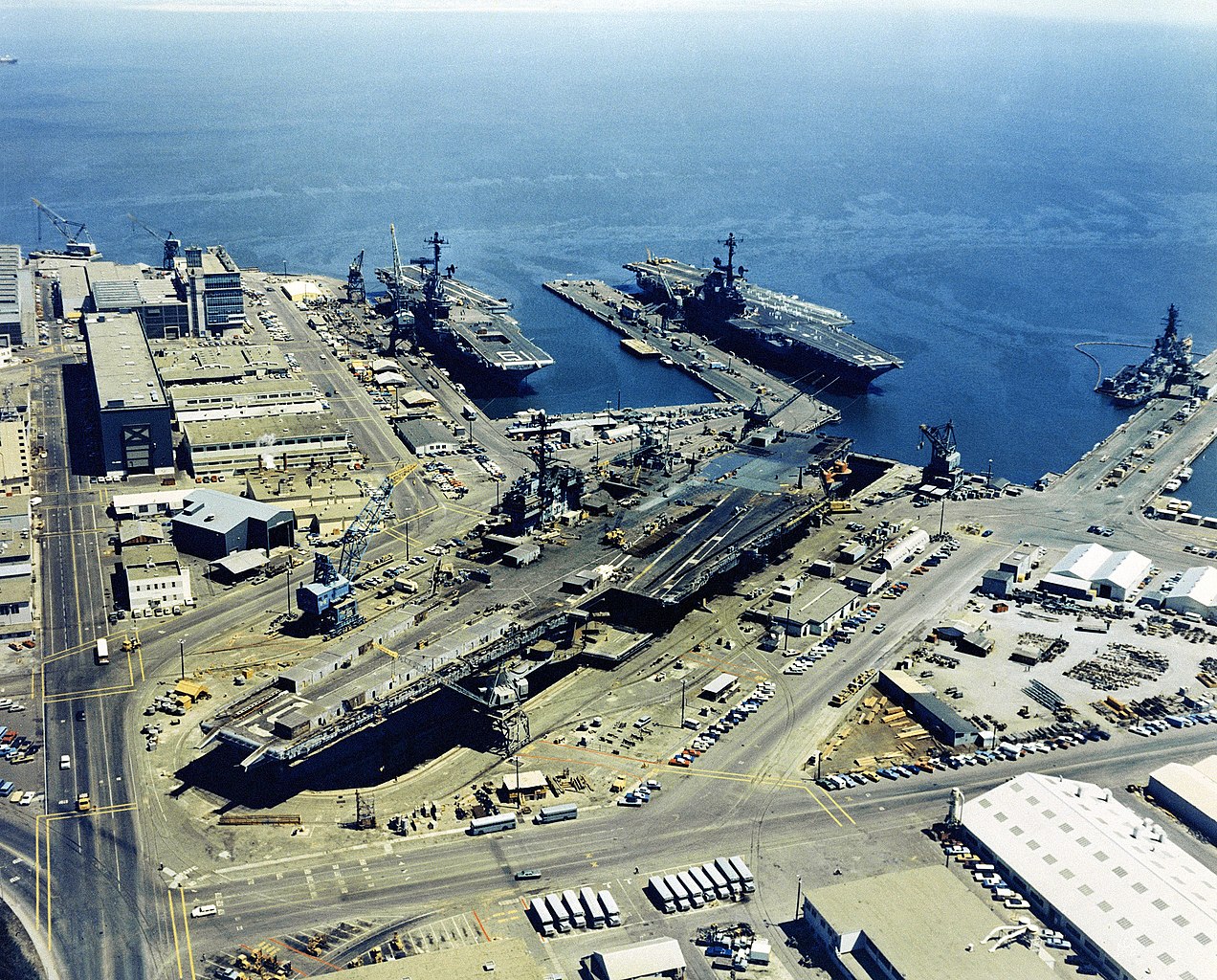
The hangar was not taller than on the Essexes due to the armour weight, and internal decks her their heights were reduced to 8ft. While “Open”, this hangar however still had to deal with structural pilars and reinforcements for the heavy flight deck, deep frames, access ladders, hatches, winches, bollards and other equipments, plus ammunition lifts and avgas stations. For safety, structural sectionalization of the hangar spacewas found desirable and made into five “compartments”. There was debate with BuAer though during the design phase, as the latter were adamant carriers needed to have open sided hangars, in order to allow aircraft to warm up, and allow rapid multiple strikes.
The fuel lines were protected by a system of vacuum and replacement by seawater, avgas tanks buried deep into the hull like the previous Essexes, so to ensure their safety. Although the flight deck was fully enclosed (no opening aside the port lift), ventilation was paramount to ensure any gasoline fuel emanations. The circuit could be however shut down in case of attack, depriving of oxygen a possible fire.
There were several fire-fighting posts along the open hangar, divided into four sections and accessed via three fire doors. Therse were also fire-proof curtains which could be deployed on these five “sub-compartments” to separate the hangar in case of a localized fire. Sprinklers were also installed as well as fog foam dispenser systems. The core dedicated fire fighting and damage control team could also train extra crewmen to deal with any emergency. Fortunately, untlike the Essex class, Midway never had to seal with such event.
On board aviation

USS Midway’s air group, 1945
1945 Air Group
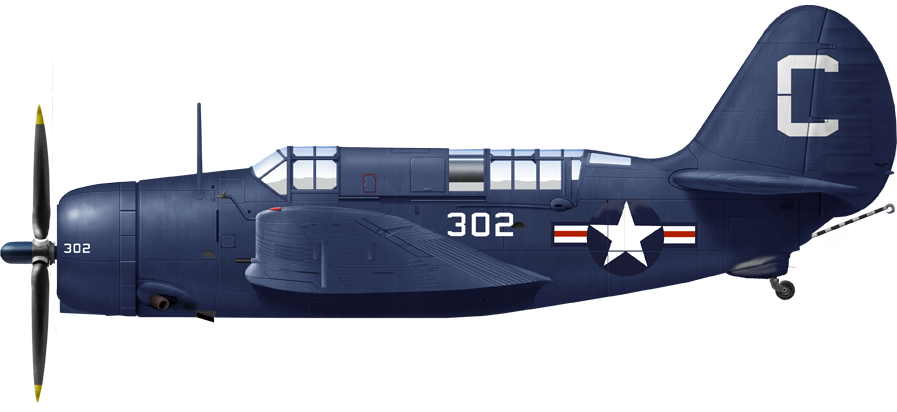
Curtiss SB2C-5 HVA5B USS Coral Sea, circa 1947.
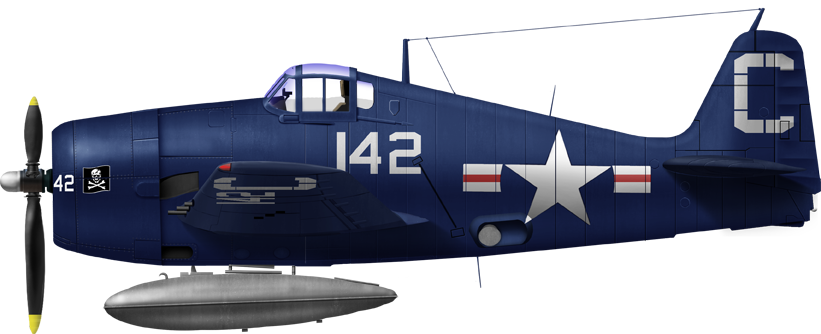
Grumman F6F-5P, VF-5B USS Coral Sea, Jan-Feb 1948.
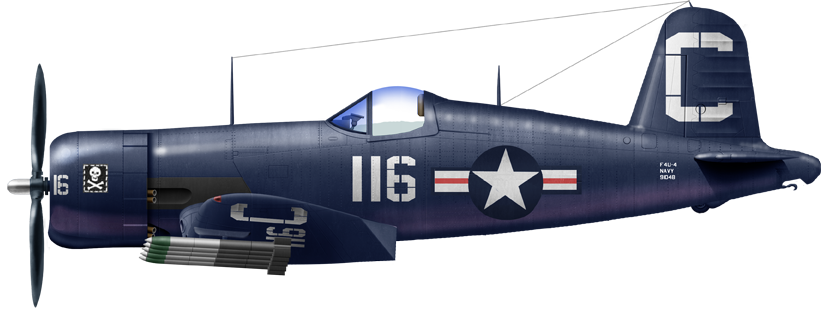
Vought F4U-4 of VF61, Air Group 6, USS Midway, 1949
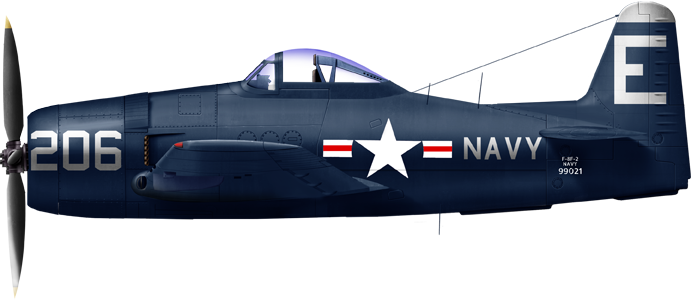
Grumman F8F-2 Bearcat, VF-82, USS Midway, August 1952
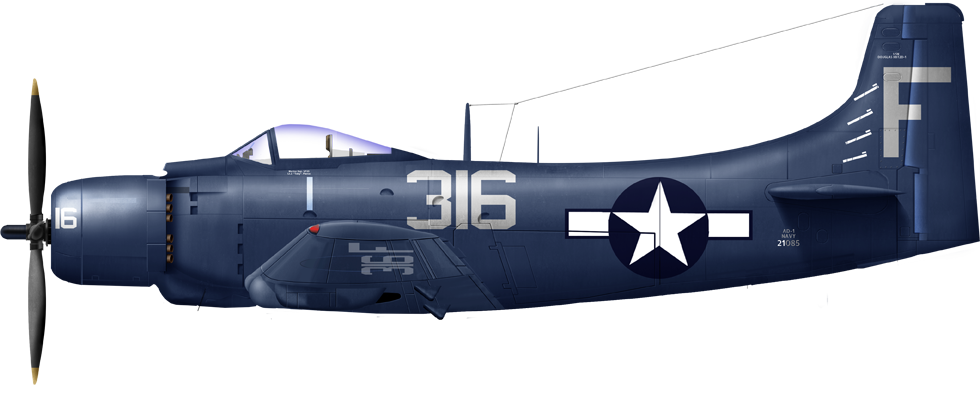
Douglas-AD-1 Skyraider VA-3B, USS Franklin D. Roosevelt, 1948
As defined for 132 planes in 1945, USS Midway air group was to comprised 132 aircraft, including 64x F4U-4 Corsairs, 64x SB2C-5 Helldivers and 4x F6F5P (photo reconnaissance) Hellcats. Corsairs were supposed to provide fighter capabilities in place of the Hellcat, as well as strafing/rocket attacks. The Helldivers were pure bombers. No consideration was given to the TBM Avenger, in order to simplify the air group, and as IJN assets had been almost all eliminated in 1945, no torpedo plane was needed; Operations when the ship was completed, likely were limited to air strikes on the home islands.
The “sunday punch” was in any case, due to the still limited flight deck size, not manageable with the while 130 planes aboard: It was calculated that with a 20 second launch and a 40-30 second landing intervals, it would need six hours to cycle the entire air group, always in the wind. This was the time required to launch six deck-load strikes. Comand & Control of such enormous air group, the largest of any aircraft carrier, anytime, anywhere, forever, was also problematic.
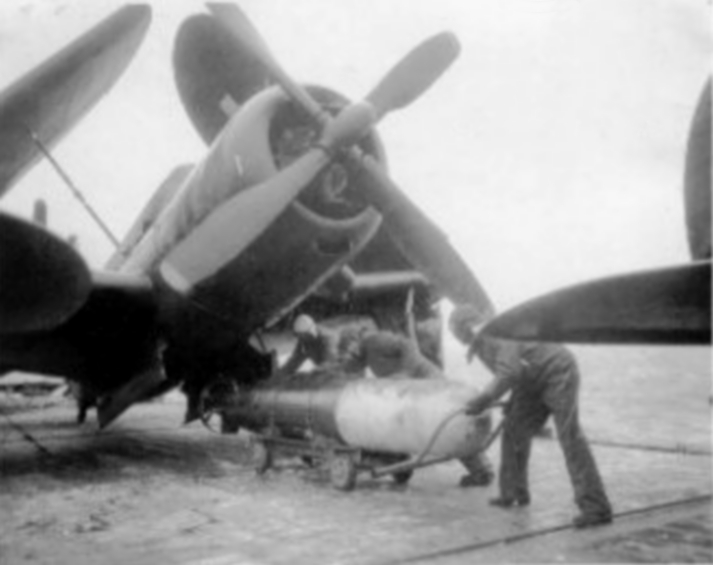
SB2C-4E loads a torpedo (VT-74) onboard CVB-41, 1946
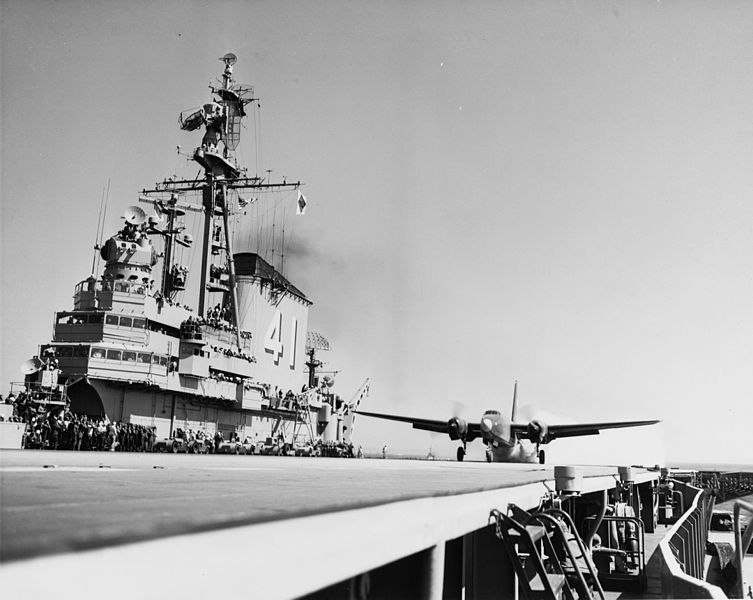
P2V Neptune takes off from USS Midway April 1949
Korean war Air Group (1950-59)

F7U-3 launched from CVB-43 in November 1952
All three operated, with little variations, the F2H Banshee, F9F Panther, F3D Skyknight, F9F Cougar, FJ Fury, F7U Cutlass. As for helicopters, HUK Husky, HUP, HO4S/HRS Chickasaw, HO5S, HSS Seabat/HUS Seahorse. In 1952 for example, USS Midway operated 84 planes, some 42 F9F Panther fighter and 42 AD-3 Skywarrior general purpose piston-planes.
Vietnam War Air Group (1965-75)
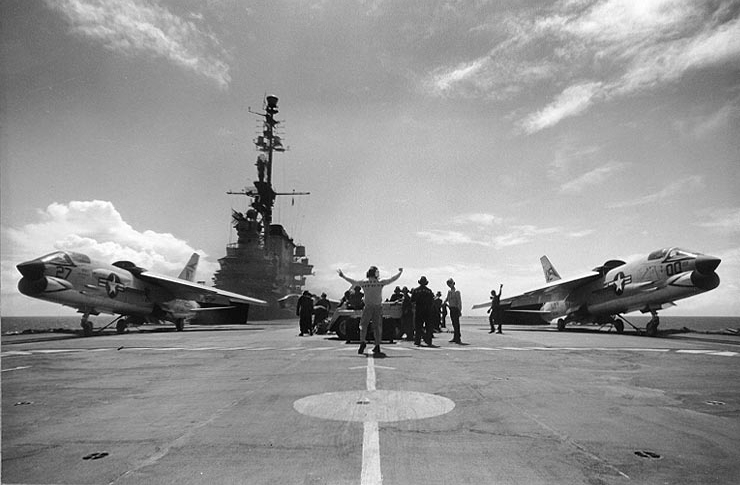
USS Midway launches Vought F-8 Crusaders in 1963
In Vietnam, the air group comprised between 60 and 80 planes and helicopters with a large variety of models since the war lasted for more than ten years:
In early period, F3H Demon, F4D Skyray, F11F Tiger, F8U Crusader fighters but also later the AD Skyraider, AJ Savage, A4D Skyhawk attackers, F2H-P Banshee, F9F-P Panther, AJ-P Banshee, F9F-P Cougar, F7U-P Cutlass, F3H Demon, F8U-P Crusader reconnaissance planes, AD-W Skyraider EW planes, and later the AD-Q Skyraider ECM planes, S2F Tracker ASW planes, F-4 Phantom II, A-5 Vigilante, A-6 Intruder, A-7 Corsair II, O-1 Bird Dog, RF-8 Crusader, RF-4 Phantom II, RA-5 Vigilante, OV-10 Bronco, EA-1 Skyraider, E-1 Tracer. Pretty much the USN operated at that time.
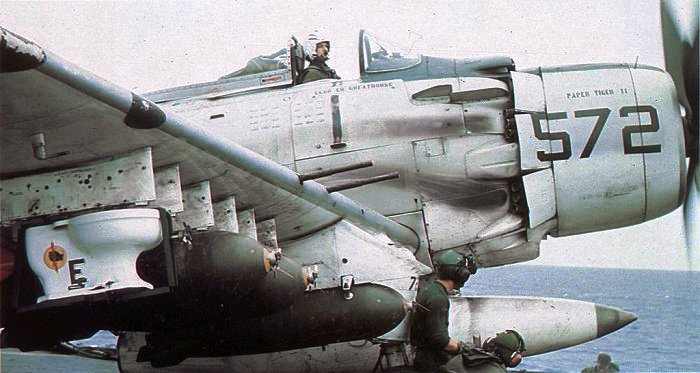
A-1H Skyraider of VA-25 with “toilet bomb”, USS Midway, October 1965
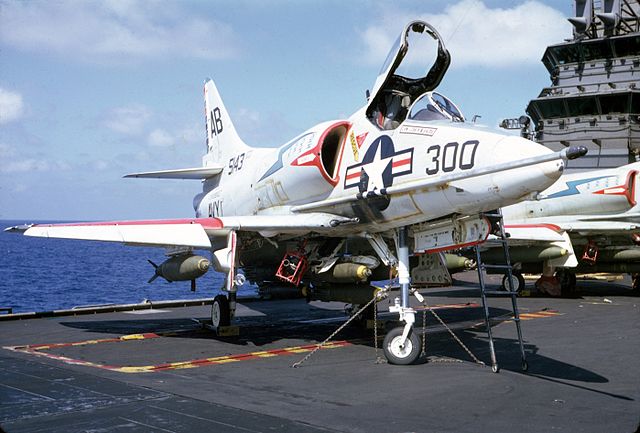
A-4C of VA-172, USS FDR off Vietnam, 1966
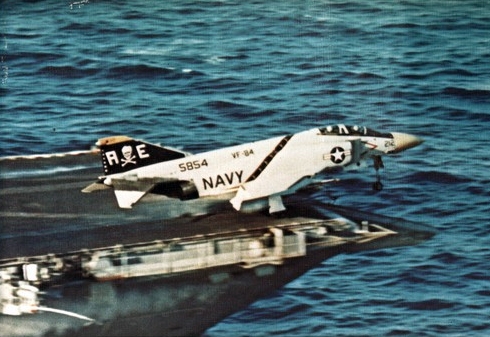
F-4J, VF-84 launched from USS FDR, 1972
In 1973, USS Coral Sea operated 24 F-4B, 24 A-7B, 10 A-6A, 4 KA-6D 4 RF-8G, 4 E-2B, 4 EKA-3B, 4 SH-3G, 4 HH-3A helicopters. As for helicopters, the SH-34 Seabat, UH-34 Seahorse, CH-34 Choctaw, UH-13, HH-13, SH-3 Sea King, CH-3 Sea King, UH-2 Sea Sprite, HH-52 Seaguard, CH-46 Sea Knight, UH-46 Sea Knight, AH-1 Huey Cobra, AH-1 Sea Cobra, HH-1 Huey, UH-1 Huey, CH-53 Sea Stallion helicopters) were operated.
Reagan-era air Group (1980s)
photo
In 1986 USS Coral Sea operated 48 F/A-18, 12 A-6E/KA-6D, 4 EA-6B, 4 EA-3B, 4 E-2C and 4 SH-3H. Also E-2 Hawkeye EW planes, the EA-1 Skyraider, EF-10 Skyknight, EA-3 Skywarrior, EKA-3 Skywarrior, EA-6 Intruder/Prowler ECM planes, S-2 Tracker ASW planes, KA-3 Skywarrior, KA-6 Intruder tankers, C-1 Trader, C-2 Greyhound cargo planes were used.
Gulf War Air Group (1990s)
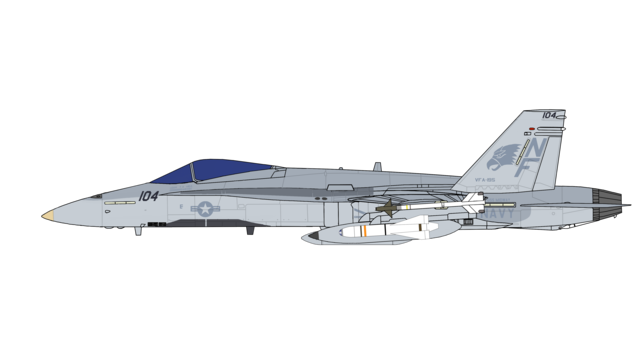
F-A 18A Hornet from VFA-195 in the 1991 Gulf War, Feb. 13 1991 (Iraqi Super-Frelon Strike).
in 1991, USS Midway operated 67 aircraft and helicopters: 36 F/A-18, 12 A-6E/KA-6D 8 EA-6B, 4 E-2C, 3 C-2A and 4 SH-3H helicopters.
Various equipments & trivia
List of extra percs:
- Crew:
- Total crew: 4,500+ including the air group pilots and mechanics
- As Designed: 3,583
- As Completed: 4,120
- Ship’s Company: 2,828 after mod.
- Air Wing: 1,860 //
- Marine Detachment: 72
- Monthly payroll: $1,200,00
- Monthly business in ship’s stores: $1,000,000
- Tech & Energy
- Number of telephones: 1,500+
- Total compartments: over 2,000
- Miles of piping: 200
- Total electric motors & components: 2,000+
- Miles of copper conductor: 3,000
- Miles of fire hose: 4.5
- Population electrical power could serve: 1 million
- Number of locomotives power equivalent to: 140
- Homes fuel supply could heat in one year: 3,000
- Daily food requirements
- Meat: 4,500 lbs.
- Dry provisions: 20,000 lbs.
- Potatoes: 3,000 lbs.
- Vegetables: 5,000 lbs.
- Bread: 1,000 loaves
- Ship’s capacity for consumable goods:
- Meals served daily: 13,000
- Number of ship’s stores: 6
- Dry provisions: 1,500,300 lbs.
- Vegetables: 205,000 lbs.
- Meat: 240,000 lbs.
- Dairy: 66,300 lbs.
- Gallons of fresh water produced daily: 240,000
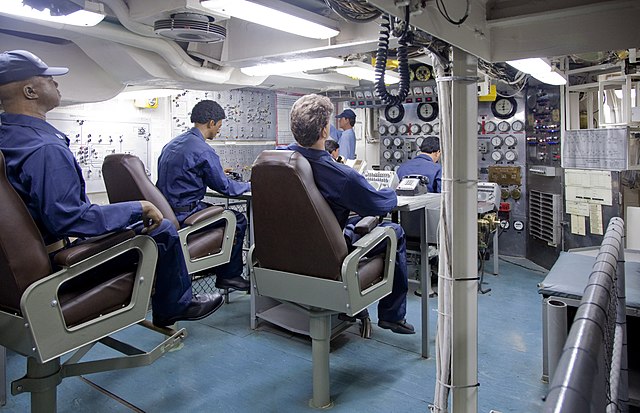
Engine control room
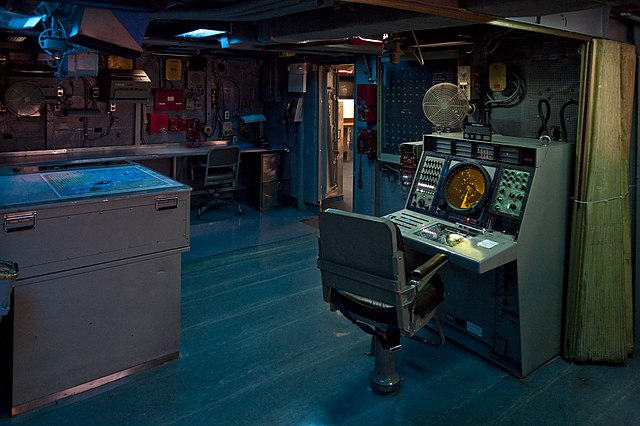
Main Combat Control Room
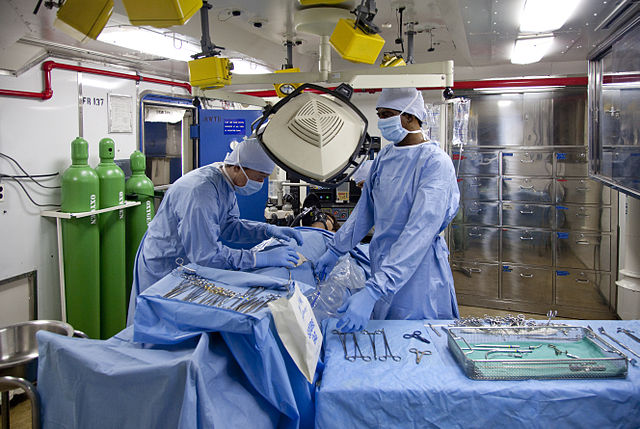
Medical Room
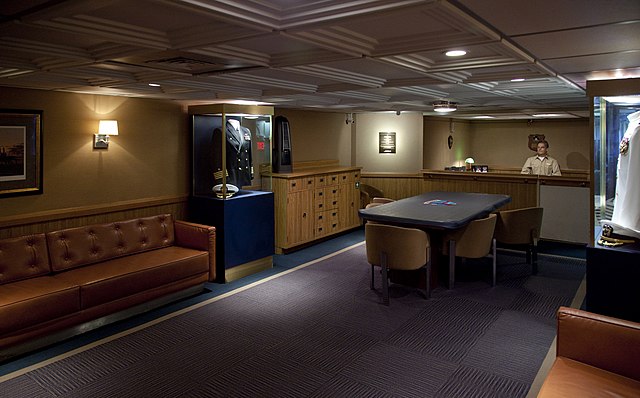
Captain’s Quarters
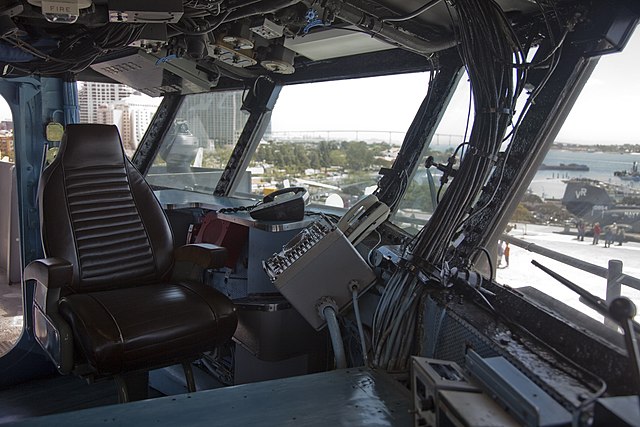
Command Bridge

Author’s profile, CV-41 in 1945
Specifications 1945 |
|
| Dimensions | 295 m long, 41.25 m wide, 10.51 m draft |
| Displacement | 47,387 t. standard -59 900 t. Fully Loaded |
| Crew | 4,104 |
| Propulsion | 4 shafts Westinghouse turbines, 12 Babcok & Wilcox boilers, 212,000 hp |
| Speed | 33 knots (61 km/h; 38 mph) |
| Range | 20,000 nmi () at 15 knots (28 km/h; 17 mph) |
| Armament | 18 x 5 in (127mm), 84 x 40 mm (21×4), 68 x 20 mm AA, 137 aircraft |
| Armor | 155 mm (6.2 in), see notes |
Cold War modernization: SCB-110 upgrade
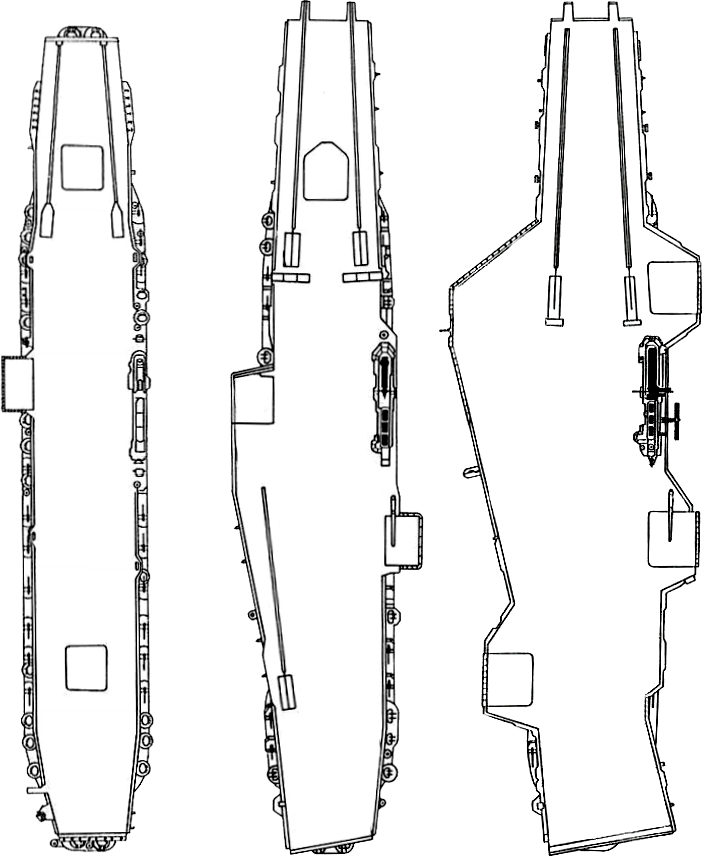
USS Midway’s successfive modernizations, 1957 and 1970

Deck plan after SCB-110 modernization, circa 1957
Cold War modernization programmes
SCB-110 1954-56 modernization
This started by USS FDR which was the prototype. The following modifications were done:
-Fitting of a “hurricane bow” to replace her separate bow and flight deck, something done already on the Essex class.
-Single extra C-11-2 steam catapult and two longer, heavier C-11-1 steam catapults forward
-Strengthened arresting gear
-Enlarged bridge, reinforced to support new radars:
-SPS-8 height finding radar
-SPS-12 air search radar on a new tubular mast.
-Mirror landing system
-482-foot (147 m) angled flight deck.
-Aft elevator relocated to the starboard deck edge
-Forward elevator enlarged and reinforced
-All elevators now able to lift 75,000 lb (34,000 kg)
-Aviation fuel bunkerage rose from 350,000 to 450,000 gallons (1,320,000 to 1,700,000 L).
-Standard displacement now 51,000 tons
-Deeply loaded displacement 63,400 tons.
-Eight 5-inch (127 mm) Mark 16 removed (10 left)
-3,200-ton armor belt removed.
-Hull blisters added for stability.
The controversial SBC-110.68 modernization (1969)
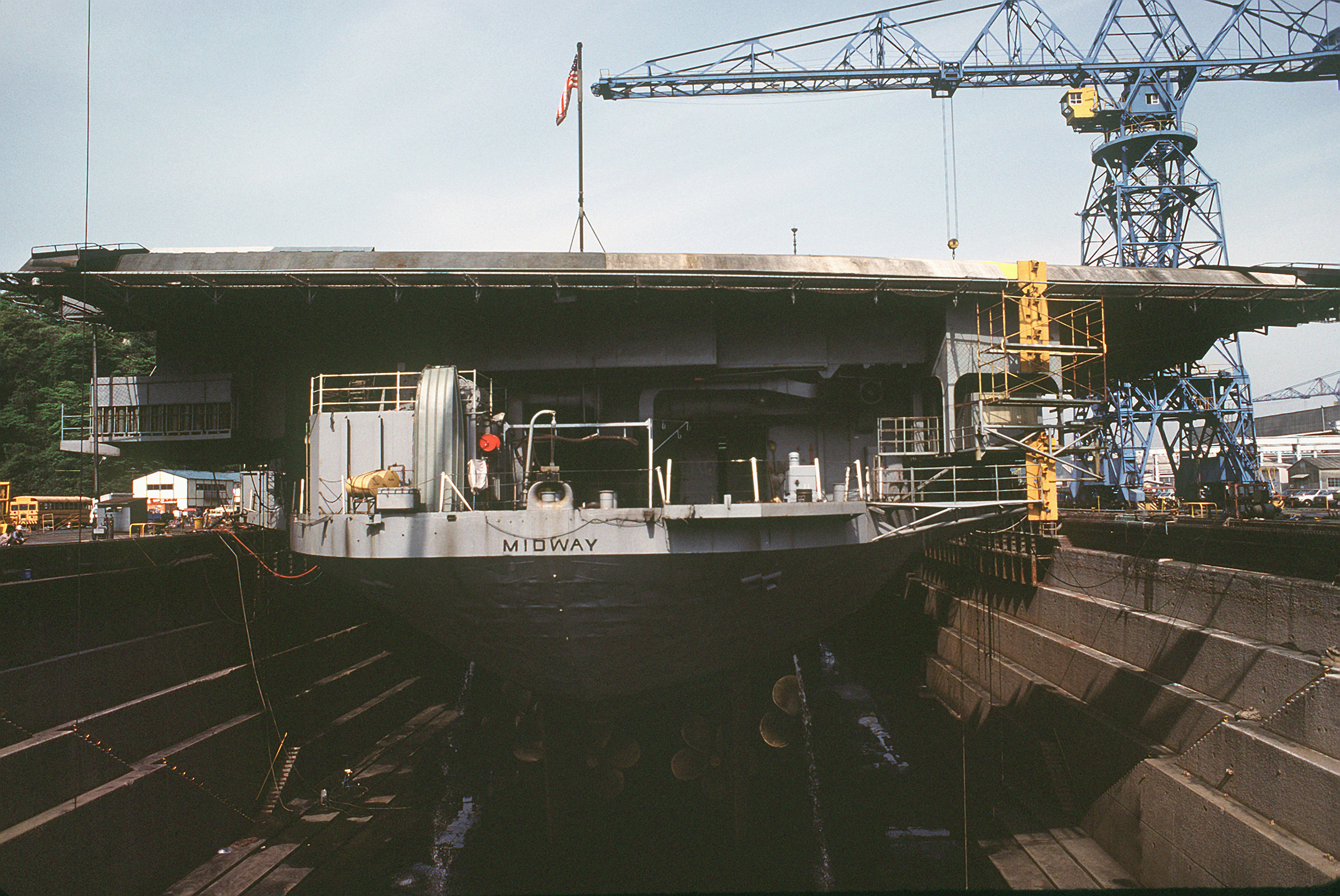
USS Midway was the prototype for this, but soon the sum of all modifications ended in a massive cost overrun
USS Roosevelt instead had an austere modernization, starting in July 1968 at Norfolk Naval Shipyard and lasting for 11-month:
-Forward centerline elevator relocated to the starboard deck edge
-Port waist catapult removed
-Crew spaces refurbished
-Two more 5-inch (127 mm) removed (2 left).
-Deck edge spray system with the seawater compatible fire-fighting “Light Water”.
-Various hangar and lifts, catapults modifications to operate the A-6 Intruder and LTV A-7 Corsair II.
The SBC-110.85 modernization
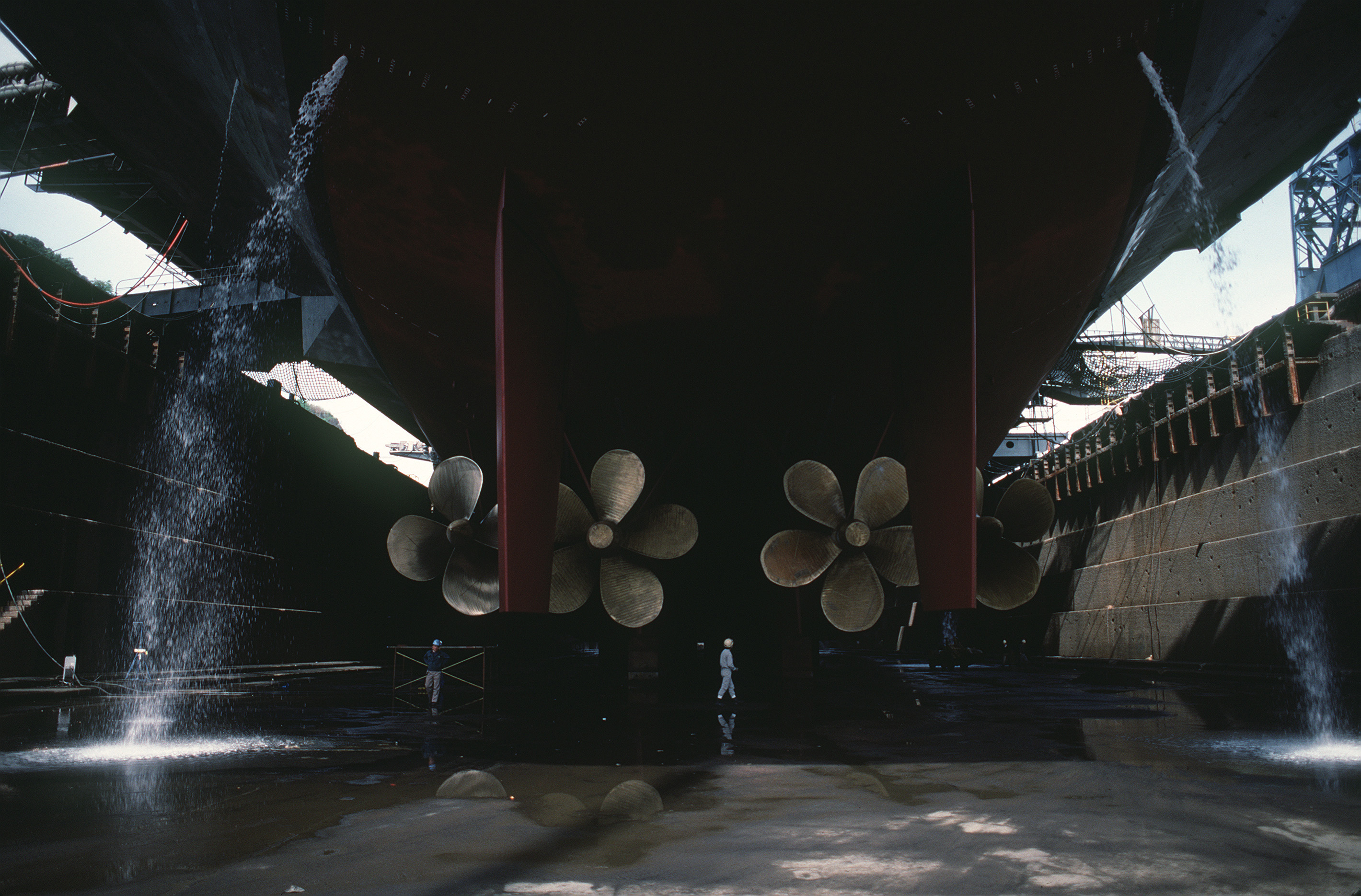
USS Midway (CV-41) poop, propellers and rudders in 1985 while under refit
Src/Read More

USS Midway post-SBC-100 (center), framed by Kitty Hawk and Nimitz, 1980s, Photo by a TARPS F-14A
Books
Conway’s All the World’s Fighting Ships, 1922–1946 & 1947-95
Aircraft Carriers of the World, 1914 to the present; by Roger Chesneau
Combat Fleets of the World 1990-1991; by The U.S. Naval Institute
San Diego Aircraft Carrier Museum
U.S. Aircraft Carriers, An illustrated Design History; by Norman Friedman
Links
The Midway class on man.fas.org
WNUS_Radar_WWII on warships.com.cn
Declassified radar info on history.navy.mil
Videos
Drachinfels on the Midway class
Midway and Operation Frostbite footage
Pathe archives, USS Midway 1947
“aboard the flattop Midway”, USNI archives
Model Kits
Available in quircky scales like the old Revell US FDR 1948 by Heller/Revell at 1:547, the more common 1:700- loose cannon (1946 v), Orange Hobby (1980), 1:700 ARII, Kangnam, Micro Ace, and the tabletop games 1:1250 by Neptun, plus a generous 3D print parts stock.
USS Midway CV-41
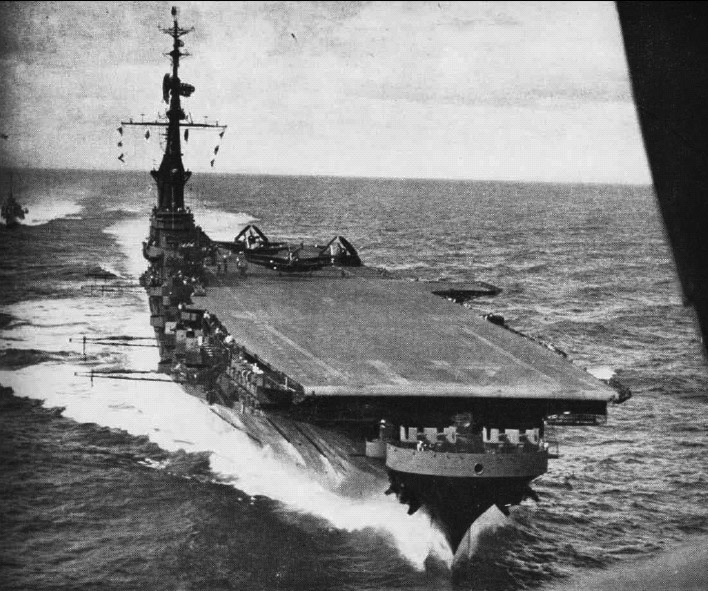
Shakedown in the Carribean Sea, early 1946
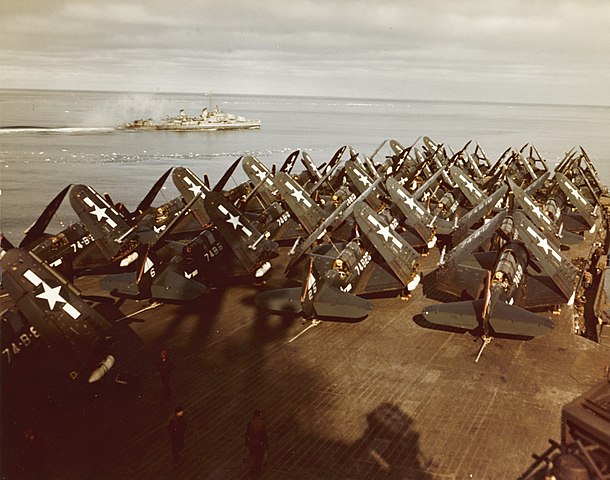
USS Midway’s Operation Frostbite, March 1946
USS Midway’s launching was sponsoored on 20 March 1945, by Mrs. Bradford William Ripley, Jr. but she was commissioned on 10 September 1945, just eight days after the Surrender of Japan. The next fifty years would have her committed in many actions. Her first captain was Joseph F. Bolger. Contrary to some sources on the internet, she was not sent in Tokyo Bay, nor used for air operations over Japan and its Occupation.

After commission
She made her shakedown in the Caribbean, and joined the U.S. Atlantic Fleet for its first postwar training planning, from Norfolk naval base. From 20 February 1946, as flagship, Carrier Division 1. In March 1946, she participated in Operation Frostbite: This was a test of the Ryan FR Fireball, and helicopter rescue techniques, for cold-weather operations: This happened in the Labrador Sea. In September 1947, this was Operation Sandy, testing a captured German V-2 rocket from her flight deck, also the world’s first launch on such moving platform. The rocket lifted off but soon tilted and broke up at around 15,000 feet (4,600 m), exploding. More tests were done from converted US Submarines, this time with the V1.
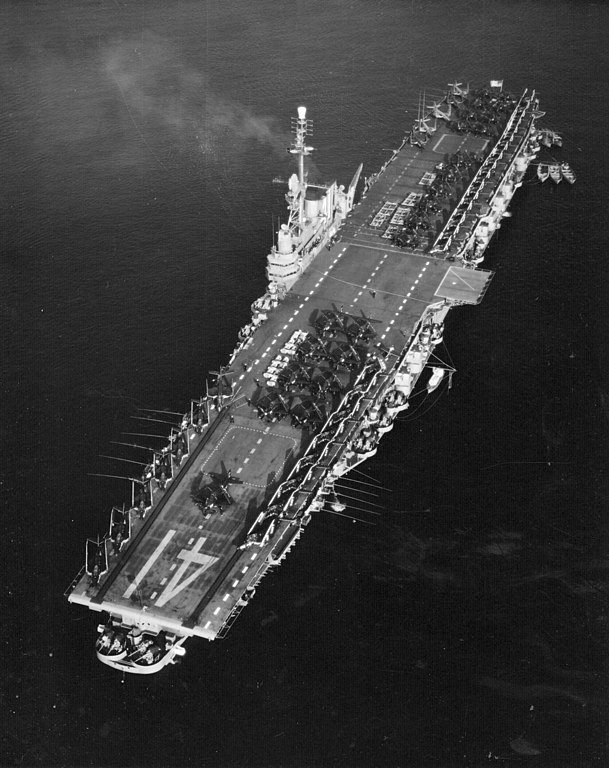
USS Midway in 1947
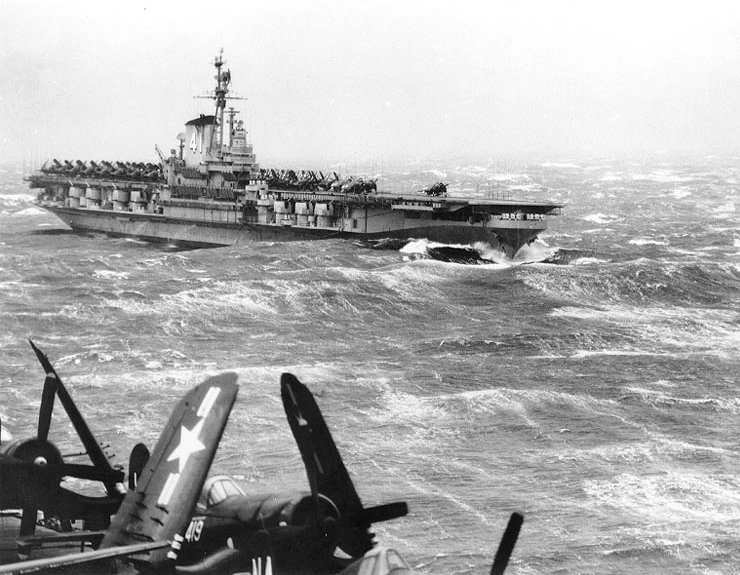
USS Midway off Sicily 1949
On 29 October 1947, USS Midway made at last her first annual deployment, with the 6th Fleet, Mediterranean. She also received a few alterations notably to her flight deck, lifts, and hangar in order to accommodate heavier aircraft planned to be deployed on board in the upcoming years. In June 1951, USS Midway was in the Atlantic, off the Virginia Capes testing the F9F-5 Panther. On 23 June however, Cdr. George Chamberlain Duncan while landed was blow off-course by a downdraft and crashed, but he survived. The footage is quite famous.
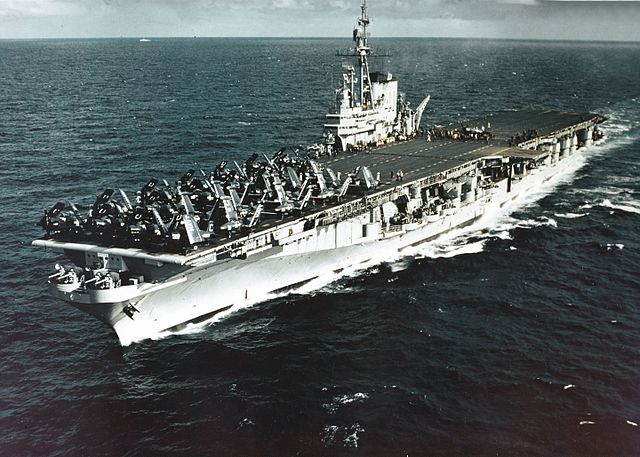
CVB-41_steaming_off_the_Firth_of_Clyde_in_September_1952
In 1952, Midway took part in Operation Mainbrace in the North Sea as a centerpiece of a NATO Task Force, one of many. In May that same year she had her angled runway painted for experimental touch-and-go landings after such tests were proven on HMS Triumph. Adoption of angled flight deck for fture CV construction or conversions made little doubts after that. On 1 October 1952, Midway CVA-41 (For “Attack”).
After a quiet 1953, 1954 and some minor modifications and maintenance, USS Midway left Norfolk 27 December 1954 for a world cruise via the Cape of Good Hope, and to Taiwan, being the first large carrier of 7th Fleet in Western Pacific Waters, until 28 June 1955. USS Midway pilots helped evacuating the Tachen Islands during the Quemoy-Matsu crisis: 15,000 Chinese nationalist troops, 20,000 Chinese civilians and livestock moved to Taiwan. it was also called the “First Taiwan Strait Crisis”. This episode in Which China, undear the US nuclear deterrence threat felt humiliated, vowed to create its own nuclear program.
Another episode was a segregation scandal of part of the crew while in Cape Town, under Apartheid. But the Navy denied such intention or effective measure. On 28 June 1955, Midway was in Puget Sound Naval Shipyard, for her first extensive modernization program SCB-110. It drew largely from the earlier SCB-125 applied to the Essex-class carriers. In addition to her new enclosed hurricane bow, aft deck-edge elevator, angled flight deck, demodelled flight deck, new steam catapults, reinforced decks and hangars (and many other modifications) she was back into service on 30 September 1957.
Post Modernization depoyments and Vietnam
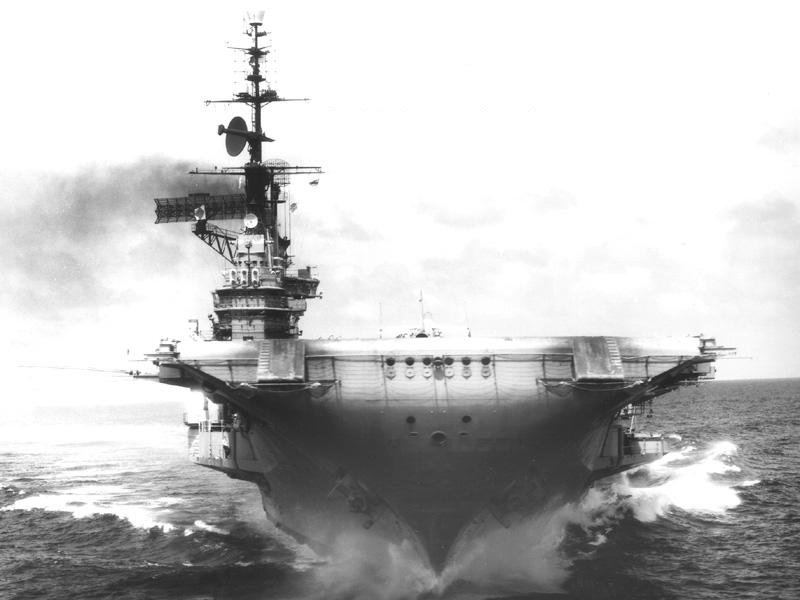
USS Midway’s storm bow after modernization, oct. 1965
Based in Alameda, California, USS Midway started her annual deployments with a brand new jet-powered air group (McDonnell F3H Demons, North American FJ-4 Furys, Vought F-8 Crusaders, Douglas A-1 Skyraiders, Douglas A-3 Skywarriors). She was assigned to the 7th Fleet in 1958 but was depliyed in the South China Sea during the Laotian Crisis (spring 1961). In 1962, a “hot” year with the Cuban missile crisis, USS Midway recorded her 100,000th arrested landing.
She tested Japanese self defence forces air warning defense systems, but also operated off Korea, Okinawa and the Philippines, or Taiwan, under a watchful eye of the PRC. She made another deployment in the Far East on 6 March 1965: As Viet-Conh started enginging southern forces in 1959, the situation escalated, with US advisors and material backing at first. From mid-April 1964, Midway launched a serie of strikes against military and logistics installations, both in North Vietnam and againsyt Viet-Congh positions in the south. In between in August 1964 the “Tonkin Incident” saw a state of war with North Vietnam confirmed and Johson ordering more troops and assets to be deployed among other ships of the USN deployed in Vietnam.
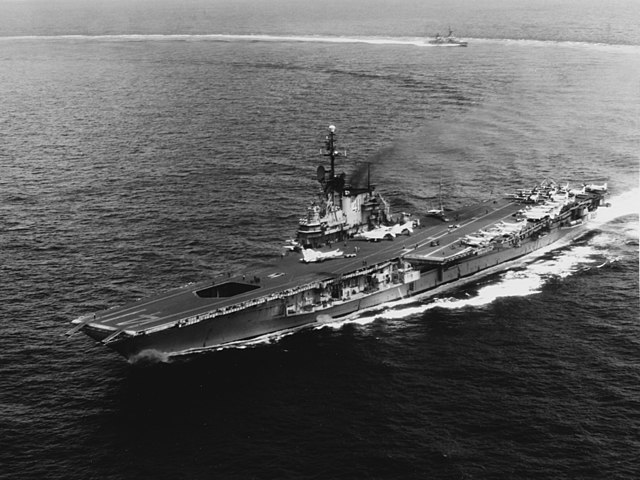
CVA-41 operating in the South China Sea in October 1965, post SBC-110
This era saw the first combat use of the AGM-12 Bullpup air-to-surface missile. Also on 17 June 1965, two VF-21 McDonnell Douglas F-4 Phantom IIs from Midway were credited with the first MiG kills in Vietnam with their (woefully innacurate at first) AIM-7 Sparrow missiles. Three days later, four A-1 Skyraiders using the WW2 “Thach Weave” tactic to down a MiG-17. A F-4 Phantom and two A-4 Skyhawks were lost on 23 November to S-75 Dvina SAMs also.
On 11 February 1966 she was back to San Francisco Bay Naval Shipyard, for her SCB-101.66 modernization, later controversial. Flight deck enlarged, angle increased, elevators enlarged and moved, massively strenghtened, new steam catapults and arresting gear, centralized air conditioning. The controversy arise fdue to cost overruns, from $88 million to a whooping US$202 million. Therefore it was cancelled for Franklin D. Roosevelt. She was in addition only recommissioned on 31 January 1970, four years afterwards. At sea, her seakeeping capabilities/air operations in rough seas were severely degraded, urging modifications.
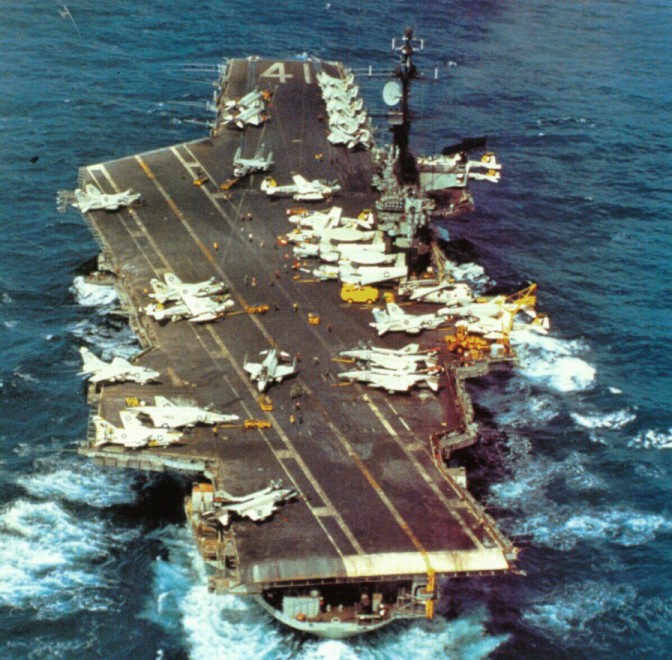
US Midway, Pacific 30_November 1974
When complete she was sent to Vietnam for her second tour of duty there, with a brand new air group on 18 May 1971. She relieved USS Hancock at Yankee Station, leaving on 5 June, than patrolling until 31 October 1971 and back home on 6 November 1971. With Air Wing 5 (CVW 5) she left Alameda on 10 April 1972. On 11 May, together with the air groups of USS Coral Sea, Kitty Hawk, and Constellation, she started lying naval mines off North Vietnamese ports: Thanh Hóa, Đồng Hới, Vinh, Hon Gai, Quang Khe, and Cam Pha or Haiphong, but the latter port was warned 72 hours in advance to avoid unnessesary collateral damage.
USS Midway was still there when Operation Linebacker started in the the summer of 1972. On 7 August 1972, one of her HC-7 Det 110 helicopter aided by Saratoga’s air group searched and rescued an A-7 Corsair II pilot, which plane was sot down by a SAM 20 mi (32 km) inland, northwest of Vinh. This helicopter made the deepest penetration even seen into North Vietnam since 1968. In total, Midway Helicopters would save 48 pilots. Her planes also made the last air-to-air victory of the Vietnam war (12 January 1973).
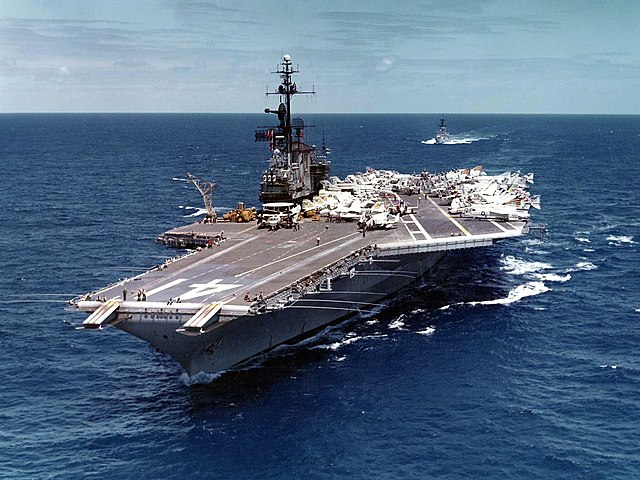
USS Midway underway in the Pacific Ocean, 19 April 1971
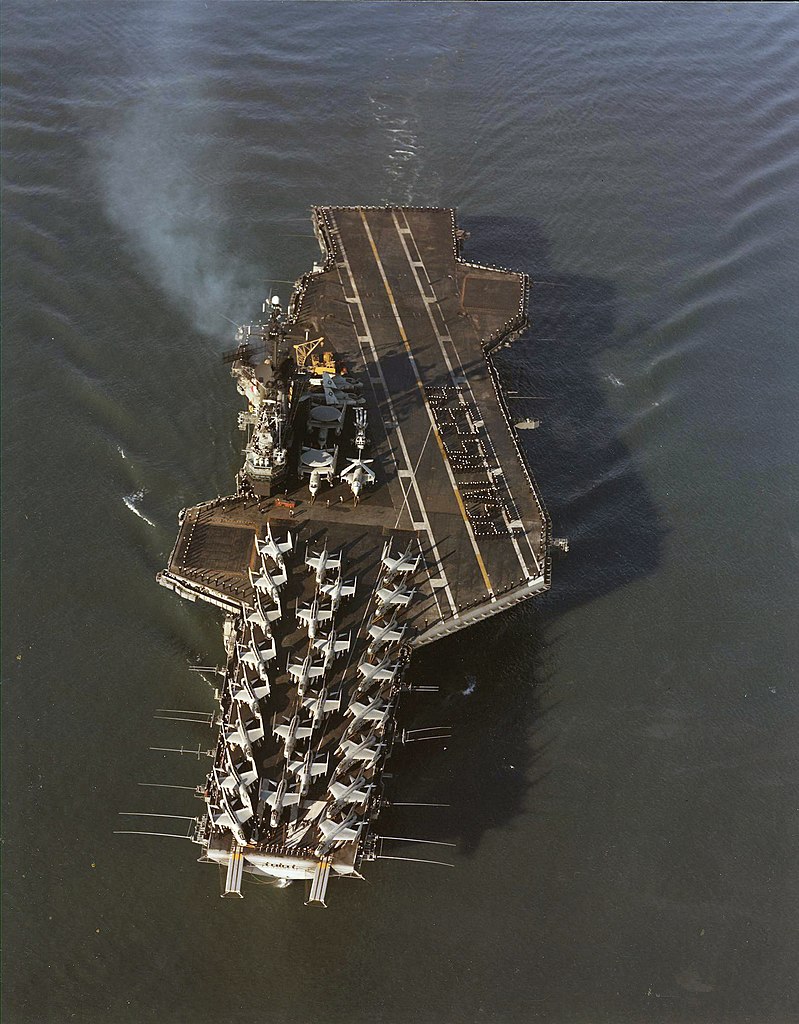
USS Midway overhead view in April 1972
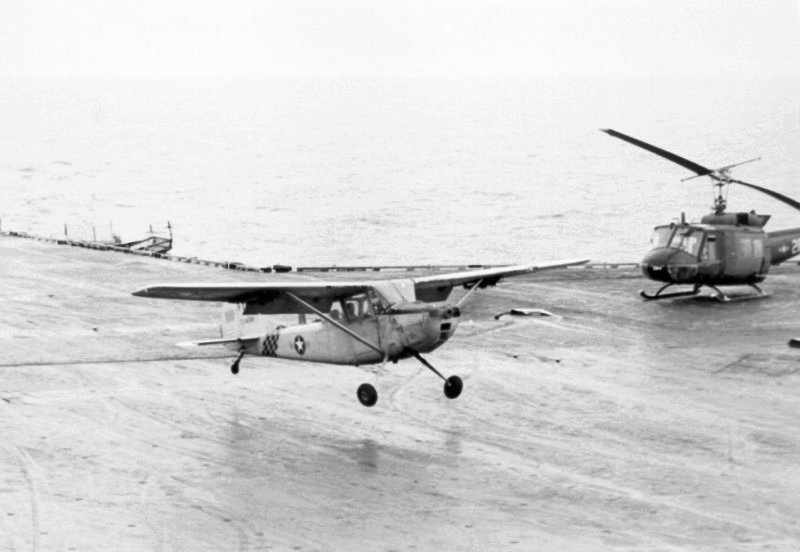
Major Buang lands his Cessna O-1 on USS Midway
On 5 October 1973, she was in Yokosuka, Japan, after the agreement of 31 August 1972 with the Japanese navy. Thus, there were three carriers based in East Asia permanently, and CVW 5 was based at the Naval Air Facility Atsugi. For her service until 9 February 1973, USS Midway and CVW 5 received the Presidential Unit Citation from Richard Nixon. Operation Frequent Wind started on 19 April 1975, with the invasion by North Vietnam. USS Midway, Coral Sea, Hancock, Enterprise and Okinaw supported South Vietnam with many strike missions on demand. The 7th Fleet next were committed in Operation Frequent Wind, the evacuation of Saigon mostly by eight U.S. Air Force CH-53 from 21st Special Operations Squadron, two HH-53 helicopters(40th Aerospace Rescue and Recovery Squadron). Her standard her group has been left in Manila. These helicopters transported hundreds of U.S. personnel and Vietnamese people to safety. On 29 April 1975, RVNAF Major Buang-Ly made a last-ditch landing with his two place O-1 aircraft with his family on board, landing in the worst possible conditions, a feat of airmanship.
Late Career: The Middle East (1976-85)
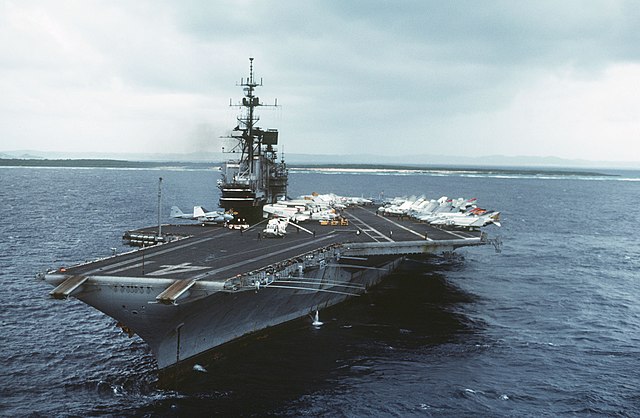
USS Midway in Yokosuka, 1984
After ferrying people to other ships, USS Midway was based in Thailand to disembark Air Force helicopters at U-Tapao (Royal Thai Navy). Over 50 RVNAF aircraft were air-lifted on Midway and when departing, she had about 100 helicopters and aircraft aboard, disembarked to Guam for the most. She headed newt to the Philippines, picking her original air wing and was re-routed to act in support of special operation forces rescuing SS Mayagüez. Again, she recuperated her air group at NAS Cubi Point (Philippines) and at last on 21 August 1976, before making for home, she became the center of a task force off the coast of Korea, in reaction to the aggresson of North Korean soldiers on 18 August on US Officer (Operation Paul Bunyan), mostly a demonstration.
USS Midway next relieved USS Constellation in the Indian Ocean, on 16 April 1979. As USS Ranger collided with the tanker Liberian Fortune near the Straits of Malacca, Midway took her place and with her escorts maintained a strong US presence between the Arabian Sea and Persian Gulf, amidst raising tensions. On 18 November 1976, she headed for North Arabian Sea, ready for operations planned after the Theran Embassy hostage crisis. On 21 November however, USS Kitty Hawk, later joined by USS Nimitz were deployed for operations on 22 January 1980, USS Midway being relieved by her sister-ship USS Coral Sea on 5 February.
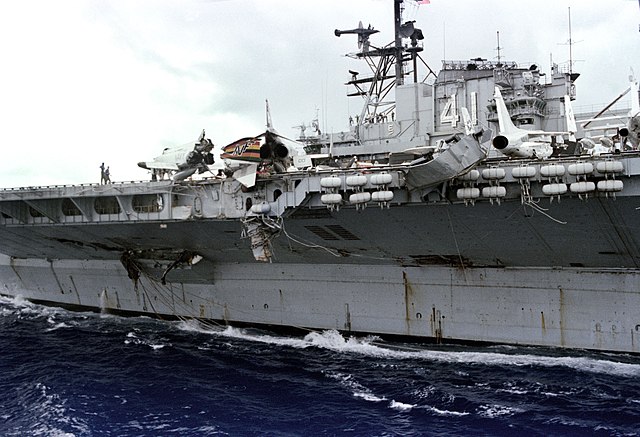
Damage after collision with the freighter Cactus
After maintenance in Yokosuka, USS Midway relieved USS Coral Sea in turn on 30 May 1980, operating south of Jeju-Do Island (Sea of Japan) while unrest rose in the Republic of Korea. While transiting in the Philippines and off Northern Borneo on 29 July she collided with the Panamanian merchant ship Cactus, stricking near Midway’s liquid oxygen plant, but overall there was light damage. On 17 August, she relieved USS Constellation in the Indian Ocean with USS Dwight D. Eisenhower task group deployed in the Arabian Sea, staying 118 days there.
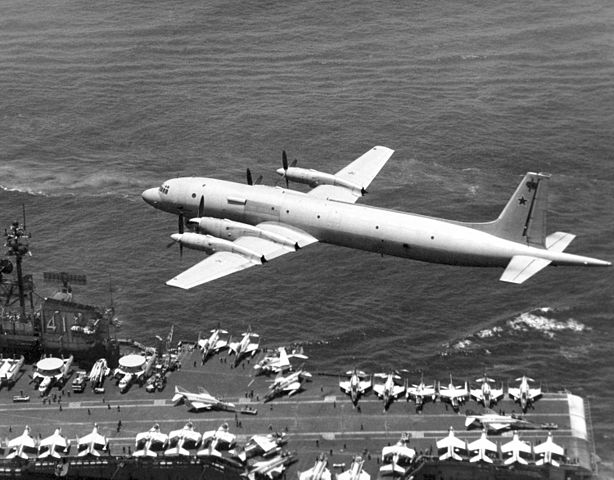
Soviet II-38 passes over USS Midway.
On 16 March 1981, her helicopters rescued the previous spotted, downed civilian helicopter in the South China Sea. On 25 March 1986, she made her final F-4S Phantom II launches in the East China Sea, pending replacement by the F/A-18A Hornet. Next she served into the western Pacific throughout for most of the 1980s. She received hull blisters in 1986 to help soliving her seakeeping issues but this refit (EISRA or “Extended Incremental Selected Repair Availability”) was counterproductive. Her instability increased in rough seas, her flight deck being swept clean at each roll. A planned $138 million refit was approved but eventually decommission was also proposed for the the “Rock’n Roll carrier” experiencing a 26-degree roll during a typhoon in the Sea of Japan on 8 October 1988.
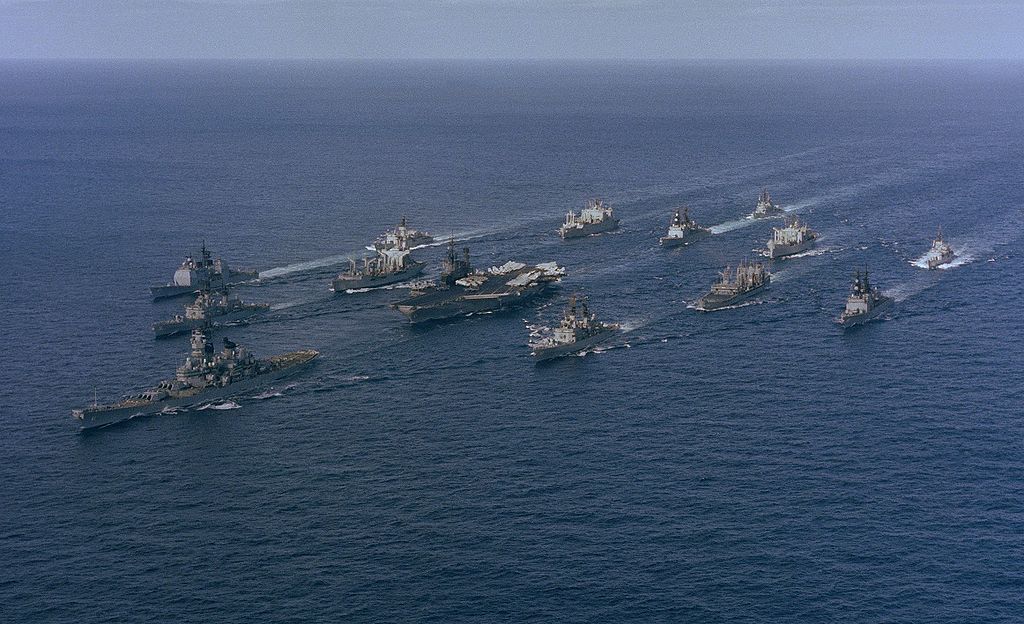
Battle Group Alpha, USS Midway and USS Iowa underway, 1987
On 30 October 1989 a single F/A-18 Hornet from USS Midway dropped a 500 pounds (227 kilograms) bomb on the deck of USS Reeves during a training in the Indian Ocean while she was 32 miles (51 km) south of Diego Garcia. Also on 20 June 1990 during flight operations, 125 nautical miles (232 km; 144 mi) northeast of Japan, two onboard explosions rocked the ship and sparked a fierce fire, raging for ten hour before mastery. The ship also had two kills, nine wounded amongst the fire-fighting team (“Flying Squad”).
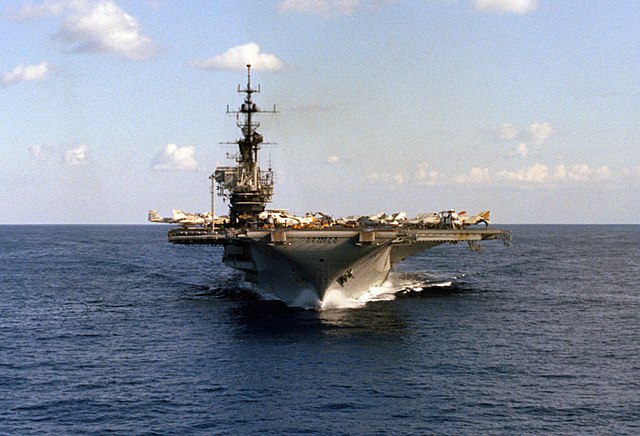

USS Midway was repaired in Yokosuka, an event which was widely mediatized by the international press. Many in the Government and Navy thought about her immediate retirement, but events caught her for a very last mission, even as her sister ships were being decommissioned.
Desert Storm
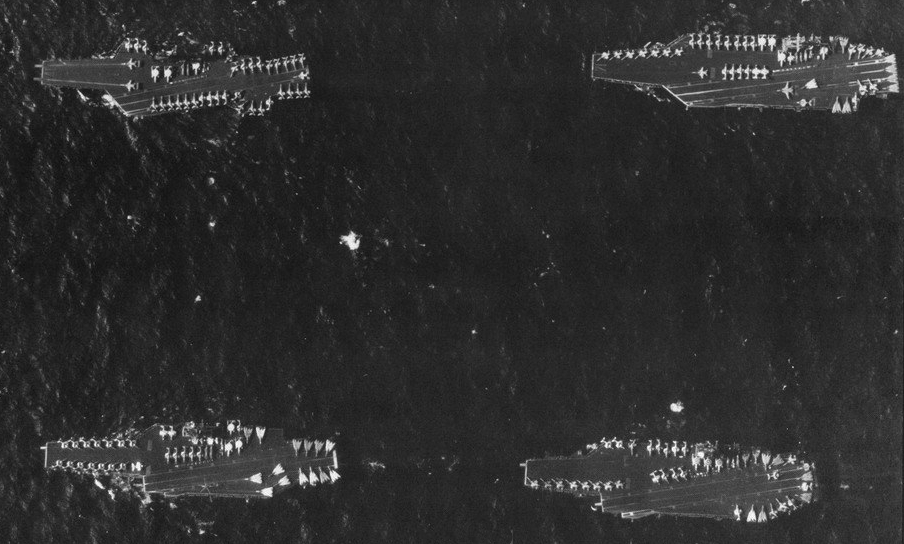
US Navy, Battle Force Zulu carriers overhead view in 1991
Four US Navy carriers were mustered to create “Battle Force Zulu” in 1991 and this included USS Midway, Ranger, Theodore Roosevelt (Nimitz class) and USS America. On 1 November 1990 USS Midway was deployed in the North Arabian Sea, the fourth carriers of “TFZ” beiong escorted by an international fleet. She relieved USS Independence and on 15 November took part in Operation Imminent Thunder, 90 days of combined amphibious landing exercise, northeastern Saudi Arabia.
After Operation Desert Storm began, on January 17, USS Midway launched some of her CVW-5 planes for the first carrier strikes, using an A-6E TRAM Intruder (VA-185 Nighthawks) led the raid, by 17 other aircraft. Four A-6E TRAM Intruders (VA-118 and VA-115 Eagles) attacked Shaibah Air Base and three A-6E TRAM Intruders (VA-115) attacked Ahmad Al-Jaber Air Base. AAA fire was fierce in both, and low-level attacks were dropped until the end of the war; In all 228 sorties the first day, from Midway and Ranger, John F. Kennedy and Saratoga (Red Sea), no loss was recorded and objectives were hit hard. Destruction was compounded by more than 100 Tomahawk missiles.
USS Midway also was the first carrier to have a Walleye deployed by an F/A-18 squadron (VFA-195) in operations, destroying the Umm Qasr Naval Base HQ. Another destroyed an Iraqi Super Frelon helicopter armed with Exocet missiles on the ground. The danger of Exocets had USS Ranger and Theodore Roosevelt moved up closer to Kuwait. Operations ended on 27 February, USS Midway departing the Persian Gulf in March for Yokosuka.
Late career and conversion as a museum ship
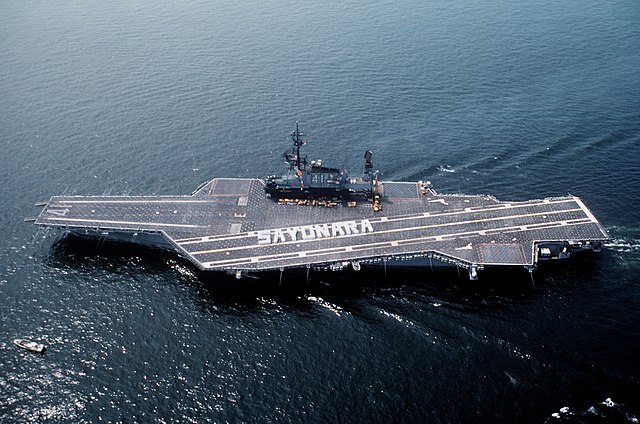
CV-41 leaving Yokosuka, spelling “Sayonara” in 1991
In June 1991, USS Midway made her final deployment to Philippines (Operation Fiery Vigil), evacuating 20,000 military members and their families from Clark Air Base (Luzon) after Mount Pinatubo erupted. She was accompanied by some twenty other U.S. naval ships. Refugees were landed in Cebu, and taken off by helicopter. She was back to Yokosuka for maintenance, but decommission was now inevitable, and probably, scrapping.
In August 1991, she left alast time her port base of Yokohama, with the crewmen’s families, and headed for Pearl Harbor. USS Independence replaceed her in Yokosuka and Rear Admiral Joseph Prueher (Carrier Group ONE) raised his flag on USS Midway for the last time, stopping to Seattle and disembarking guests of crew members before proceeding to San Diego.
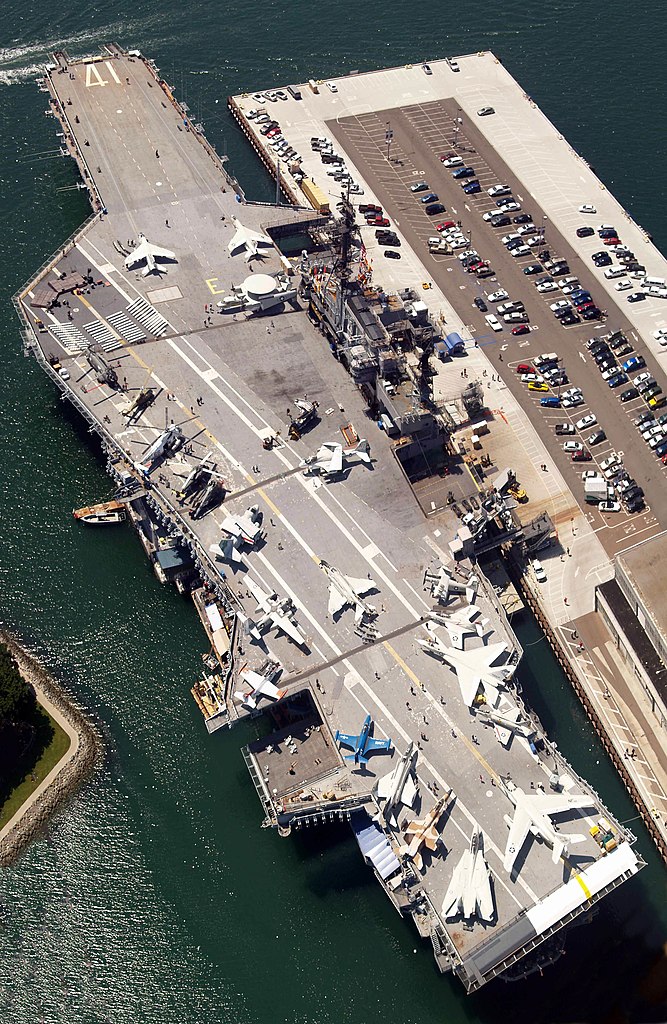
Decommissioned at Naval Air Station, North Island, on 11 April 1992, USS Midway had the honors of a special ceremony headed by Secretary of Defense Dick Cheney. The crew was filmes for the documentary movie “At Sea”, at the Navy Museum in Washington, D.C. Stricken on 17 March 1997, she was mothballed there, waiting for her fate, which was likely to be converted as a carrier due to her age. Preparations went on until on 30 September 2003, she was sent to the Navy Inactive Ship Maintenance Facility in Bremerton (Washington) and San Diego (California) to be converted as as a museum ship and memorial. She was docked by October 2003 at the Charles P. Howard Terminal, Oakland, Cal. and Broadway Pier, San Diego. On 10 January 2004, she opened to the public on 7 June 2004, receiving a massive attendance. She is still there to be visited by all, at Navy pier, San Diego.
USS F.D.Roosevelt CV-42
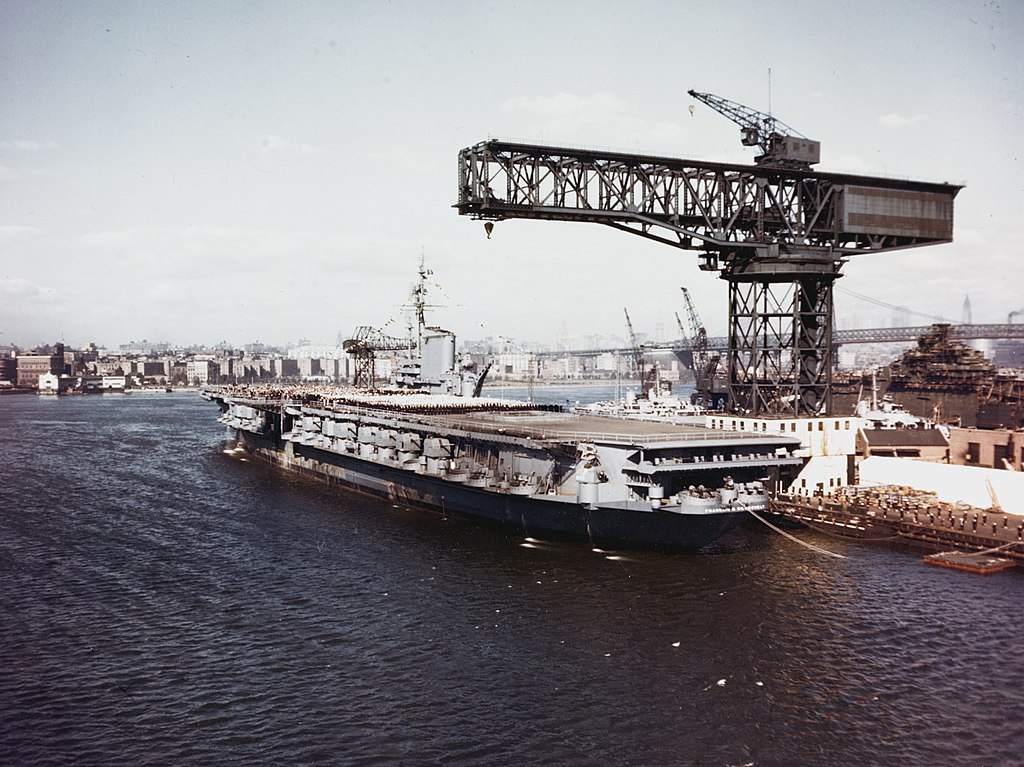
Commissioning of USS Franklin D. Roosevelt at the Brooklyn Navy Yard on 27 October 1945
Franklin D. Roosevelt was commissioned on Navy Day, 27 October 1945, drawiong medias and a crowd at the New York Naval Shipyard. Capt. Apollo Soucek became her first CO, bringing her to a shakedown cruise down to Rio de Janeiro (February 1946), representing the United States in honor of president Eurico Gaspar Dutra being elected, and hosted him aboard, for a short cruise. In April-May, she was assigned to the 8th Fleet, for maneuvers off the East Coast, a large set of exercises.
On 21 July 1946, her CO and staff worked out her very first all-jet air group, under controlled conditions. Lieutenant Commander James Davidson flew the McDonnell XFD-1 Phantom successfully off Cape Henry in Virginia, and in November, Lt. Col. Marion E. Carl was catapulted and made landings with a Lockheed P-80A, eventally not adopted for carrier service.
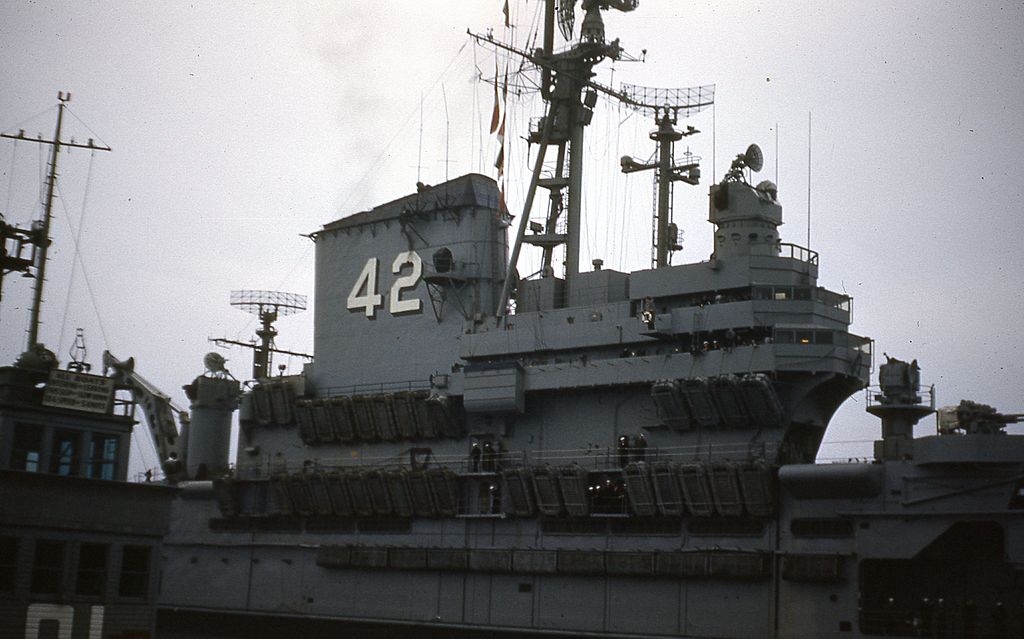
FDR island at Navy pier, Seattle 1954
Fleet maneuvers in the Caribbean was followed by her first cross-atlantic journey to serve in the Mediterranean, arriving in August, and up to October 1946 as flagship, Rear Admiral John H. Cassady (Carrier Division 1) leading the Piraeus Task Force operational from 5 September 1946. This visit and strenght gave comfort to the pro-Western government of Greece caught in a bitter communist-led civil war. She hosted thousands of visitors while touring Mediterranean ports as the largest warship to ever sail the Mediterranean initiating the American aircraft carrier later transformed into the permanent Sixth Fleet.
In late 1946 and 1947 she operated on the East Coast, back in the US, and in July was hit by a storm that damaged her bow notably, forcing repairs in Norfolk Naval Shipyard, prolongated by an extensive overhaul with her 40 mm Bofors removed and the latest 3-inch (76 mm) Mark 22 guns installed, in ten Mark 33 twin mountings. From September 1948, until to January 1949 she returned in the Mediterranean.
In 1950, she had nuclear weapons onboard when participating in Operation Mainbrace (September-October 1952) in the North Atlantic. She sailed with USS Midway, USS Wasp, and HMS Eagle, escorted by the BBs USS Wisconsin and HMS Vanguard.
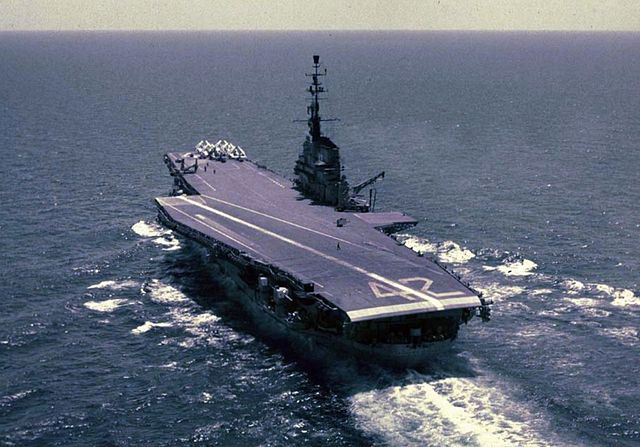
FDR underway in 1958
Reclassified CVA-42 from 1 October 1952 her home water routine home proceeded in 1953, until a major reconstruction in 1954 at Puget Sound Naval Shipyard, but the added blister prvente her to cross the Panama Canal, so she had to round Cape Horn in order to get there on 5 March 1954, inaugurating the SCB 110 reconstruction. Its cost at the time was about $48 million and she was recommissioned on 6 April 1956.
After post-refit trials, she was based on Mayport, Florida. On February 1957, she started cold weather tests, which included the recently fitted Regulus guided missile. This happened in the Gulf of Maine. In July 1957, she departed for the Mediterranean and 6th fleet, the first of three deployments. This was combined with a routine of NATO exercises and major fleet operations. She had a 1958 mid-year overhaul, in which the remaining 5-in guns were removed for good;
On 24 October 1958, USS Franklin D. Roosevelt was assisting USS Kleinsmith evacuating merican citizens from Nicara in Cuba during the Cuban Revolution. In 1960, her first production Fresnel Lens Optical Landing System (FLOLS) was installed onboard, manufactured by the Control Instrument Company. She celebrated her 100,000th aircraft landing in March 1961. She was overhauled in 1963 and lost all her remaining artillery, her last six 5-inch guns, now obsolete.
While in the Eastern Mediterranean, late 1964, she lost a propeller blade and was prvisionally fixed in Naples, enough to sail back to New York with her N°1 shaft locked. It was replaced in Bayonne, New Jersey and she departed again to conclude her Mediterranean deployment. From August 1966 to January 1967, she was called in Southeast Asia, like most of the USN, making there a 95 days frontline tour of duty. Carrier Air Wing One (F-4 Phantom IIs and A-4 Skyhawks) brough a significant support to air operations, enoigh for the aircraft carrier to Roosevelt earn one battle star for this unique Vietnam War deployment.
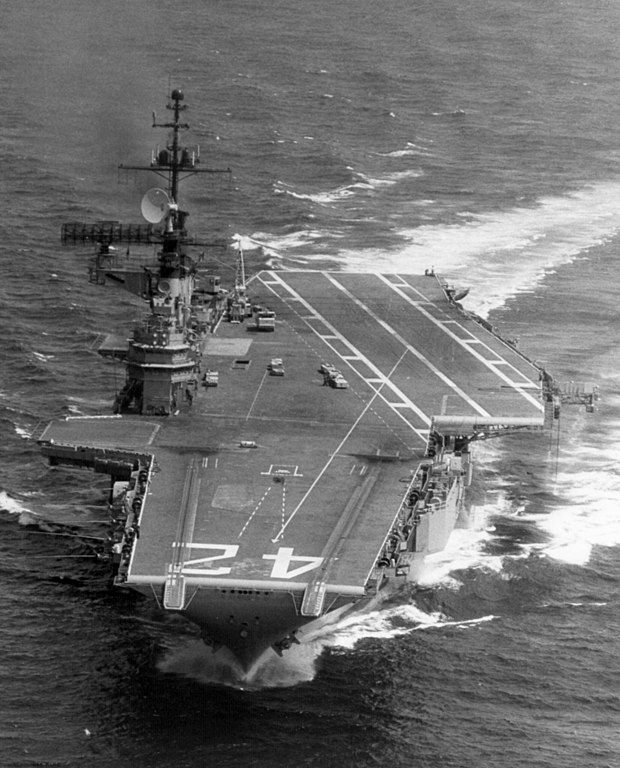
USS FD Roosevelt after refit 1969
In January 1968, the CV hosted actress Virna Lisi during her 22nd birthday celebrations. This was to be followed by the same extensive reconstruction (SCB 101.68) applied to USS Midway in 1966-1970. But due to its massive cost overruns, Roosevelt had an austere $46 million refit called SCB 103.68 instead. It was limited to enabler her to operate the Grumman A-6 Intruder and LTV A-7 Corsair II. This was over and she was recommissioned on 26 May 1969.
From 1st August she embarked Carrier Air Wing Six, which served as the ship’s air wing for the next seven cruises. In January 1970, Roosevelt returned to the Mediterranean for another Sixth Fleet deployment. She made her 21st 6th Fleet deployment as a witness of October 1973 Yom Kippur War, used as a “landing field” for aircraft delivered to Israel. As part of Task Force 60.2 evacuation contingencies plans were drafted in case.
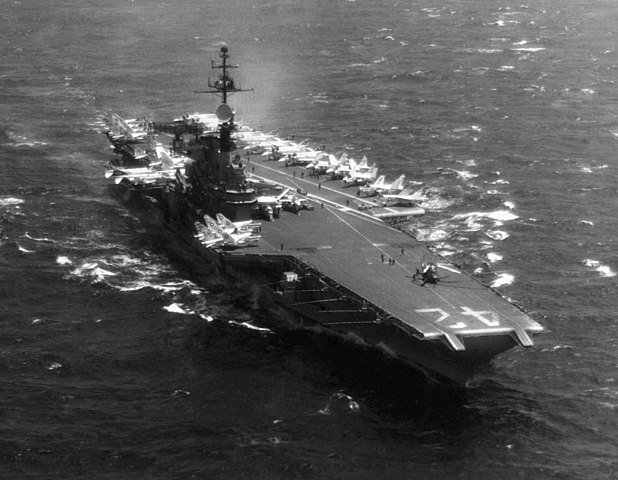
USS_Franklin_D_Roosevelt_Mediterranean_1971_after_austere-refit
In 1973-1975, her new air group VAW-121 was the last to operate the Grumman E-1 Tracer. As CV-42 from 30 June 1975, she was left witout ASW capability. In June 1976, she carried instead VMA-231, equipped with fourteen 14 AV-8A Harrier instead for testings and Carrier Air Wing 19 for her final deployment from October 1976 to April 1977.
VMA-231 demonstrated VTOL capabilities alongside fixed wing air operations, and measured were taken not for their hot exhaust burn painted non-skid surfaces, also blowing detached pieces of the coating. They were removed, but this was taken in account for the operating assault ship’s own decks. On 12 January 1977, USS F.D. Roosevelt collided with the Liberian grain freighter “Oceanus” in the Strait of Messina but damage was light. Shen left the Mediterranean and called home.
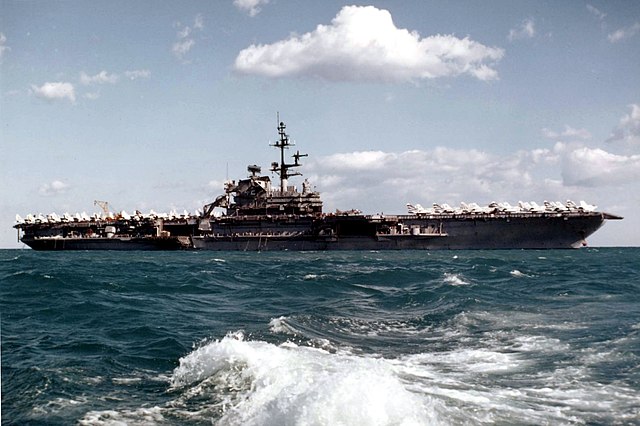
USS Franklin D. Roosevelt at anchor in 1976
Since her last refit, it was established the ship was in generally poor material condition and due to hher auster modernization, proved the least capable of the class. General Electric turbines, she was alone to operate (the others had Westinghouse units) were problematic as well. In the end decision was made to have her decommissioned and replace her by the second Nimitz-class carrier, Dwight D. Eisenhower.
She was decommissioned on 30 September 1977, stricken the same day but funds lacked to have her preserved in New York City. She was not even sent to the reserve fleet, and to counter the Carter Administration’s cost-saving measure, potentially targeted as the costly Nimitz-class carriers, she was sold on 1 April 1978, to the River Terminal Development Company, for $2.1 million, towed to Kearny (3 May 1978) for scrapping.
USS Coral Sea CV-43
_underway_at_sea_on_11_February_1948.jpg)
USS Coral Sea at sea in February 1948.
Early Career 1948-57
As soon as she was commissioned, USS Coral Sea saw on 27 April 1948 saw a test with two P2V-2 Neptunes making assisted takeoffs (JATO) commanded by Cdr Thomas D. Davies and Lt. Cdr John P. Wheatley off Norfolk. This was the first carrier launchings of that magnitude. On 7 June 1948 she made a midshipmen cruise to the Mediterranean and when back to the Caribbean before returning to home port Norfolk, Virginia, on 11 August. After an overhaul she was seen training off the Virginia Capes.
On 7 March 1949 she made a P2V-3C Neptune (John T. Hayward, VC-5) launching, this time carrying a 10,000-lb dummy bombs payload, dropped on the West Coast, returning nonstop to NAS Patuxent in Maryland to test the concept of carrier-borne atomic bomb attacks. At the same time, the USS United States was designed for this purpose and laid down (and cancelled) in April. After her seasonal Caribbean training, departed on 3 May 1949 for her first long Mediterranean tour with the 6th Fleet until 28 September.
On 21 April 1950, the first AJ-1 Savage heavy attack bomber (Captain John T. Hayward, VC-5) made a first takeoff from her deck. Carrier qualifications with these were complete on 31 August, and she made a second TOD (Tour of Duty) in the Mediterranean (9 September 1950-1 February 1951). After a new periodic overhaul she resumed local operations and trained with Air Group 17 for 3rd TOD in the Mediterranean on 20 March 1951. She became flagship, CarDiv 6, for NATO’s “Beehive I”. Back in Norfolk on 6 October for Caribbean training and 4th Med TOD on 19 April 1952.
She stopped in Yugoslavia by September, hosting Marshal Josip Broz Tito on a one-day cruise while reclassified as “Attack Aircraft Carrier” (CVA-43) on 1 October 1952 she was back to Norfolk on 12 October for her periodic maintenance. After air group training off of the Virginia Capes and NAS Mayport by April 1953 she carried the Judiciary Committee of the House of Representatives for a 3-days cruise and on 26 April, made her 5th Med TOD, visiting Spain, and taking part in NATO “Black Wave” with Deputy Secretary of Defense R. M. Kyes on board. After her return to Norfolk on 21 October, she performed tests for the Bureau of Aeronautics (BuAer) and the Naval Reserve, pushing to Guantánamo Bay.
Her 7th Med TOD (7 July-20 December 1954) accomplished (she hosted Generalissimo Francisco Franco while in Valencia), the rest of the year ws uneventful, between winter’s training in the Carribean and east coat exercises. Her 8th Med TOD lasted from 23 March to 29 September 1955, calling Istanbul and making another NATO exercise. On 23 July 1956 she departed for Mayport in Florida to embark Carrier Air Group 10 and making her 9th Med TOD with the 6th fleet and NATO exercise, this time hosting King Paul of Greece and his wife Friederike Luise Thyra of Hanover. The Suez Crisis saw her evacuating American citizens from Egypt until November 1955.
Major Reconstruction and Pacific Service
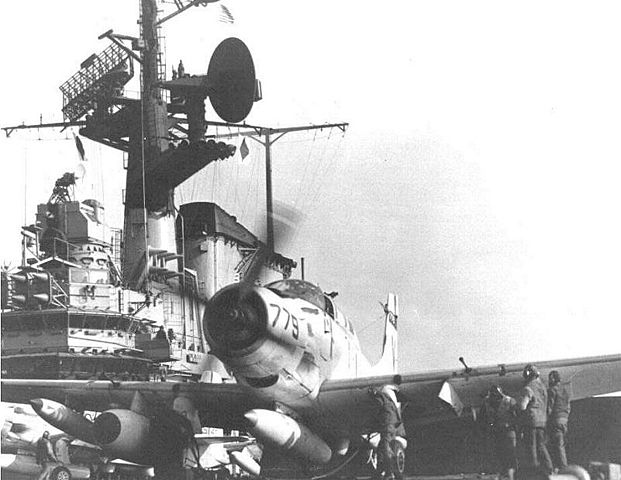
EA-1F from VAW-13 taking off in the 1960s, Vietnam
Back to Norfolk for maintenance on 11 February 1957, she departed on 26 February for Santos in Brazil and Valparaíso in Chile, also visiting and Balboa and the Canal Zone and calling for Bremerton (Washington) on 15 April, after rounding the cape. Like her sisters, she was too wide to cross the Panama canal. She made it to Puget Sound Naval Shipyard, on 24 May 1957 for her SCB 110A reconstruction. She became tje first carrier to mount an elevator on the port quarter, inspired by the Kitty Hawk-class design. Recommissioned on 25 January 1960 she trained with her new air group along the West Coast and made her first PAC TOD or “WestPac” (Western Pacific cruise) with the 7th Fleet, Far East.By october she celebrated her 100,000th arrested landing.
On 14 December 1961 she was the first USN carried fitted wth the Pilot Landing Aid Television (PLAT) system, greatly helping landings as it provided a videotape for briefings and instructional purposes, analysis of accidents. It was widespread by 1963. The Gulf of Tonkin incident in August 1964 saw USS Coral Sea for her second WestPac on 7 December 1964 and on 7 February 1965, with USS Ranger and Hancock, she launched her air groups for Operation Flaming Dart targeting military barracks and staging areas close to Đồng Hới, North Vietnam.
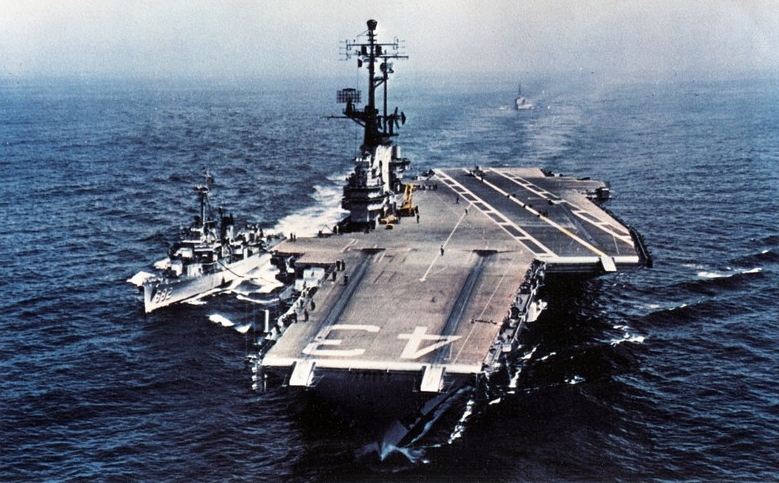
USS Coral Sea refuelling at sea in 1960
These raids in retaliation for a Viet Cong attack on installations around Pleiku were followed from 26 March by the start of Operation Rolling Thunder over North Vietnam. USS Coral Sea air group focused on island and coastal radar stations off Vinh and on 3 April, the carrier’s CAP took off to intercep MiG-17s with USS Hancock, first to see aerial combat. One of her RF-8 also took the first shots of NVA SAM batteries two days later, and she stayed on station until 1 November 1965. Her second deployment went from 29 July 1966 to 23 February 1967.
This summer she became “San Francisco’s Own.”, the carrier enjoying a formal and official relationship. In July 1968 she also saw the first trials of the F-111B. More WestPac deployments followed until the end of the war, notably between 26 July 1967 and 6 April 1968, 7 September 1968-15 April 1969, 23 September 1969-1 July 1970, 12 November 1971-17 July 1972, 9 March 1973-8 November 73 and 5 December 1974-2 July 1975 with a peak of activity in April 1972, always with USS Hancock on Yankee Station, later joined by USS Kitty Hawk and Constellation, bringing close support durng the Tet Offensive. On 16 April 1972 alone, she flew 57 sorties in the Haiphong area, mostly aescorting B-52 Stratofortress strikes on Freedom Porch.

Leaving Pearl Harbor in 1963
Back home she made her refresher training (REFTRA) in 1971 in San Diego and while underway to Alameda she caught fire as the communications department erupted, spreading so fast that Captain William H. Harris had her ship stationed offshore to potentially abandon ship. Due to their heroic savings, several crewmbers were later awarded. The fire was mastered ahs was repaired during her yearly overhaul. When back in Vietnam she took part in Operation Pocket Money, mining North Vietnamese ports from 9 May 1972, later marred by Poor weather.
USS Coral Sea launched three A-6A Intruders and six A-7E Corsair II to lay naval mines, with a EKA-3B Skywarrior in support, off Haiphong Harbor. In all, circa 11,000 MK36 type and 108 special Mk 52-2 mines were layed over eight months. That some says contributed to give more weight to the US during peace arrangement. However widespread dissatisfaction with the War saw about 1000 crew members creating the assoc. Stop Our Ship (SOS), petitioning against the war, and on 6 November 1971, over 300 marched in the San Francisco anti-war demonstration, as well on 12 November 1971 off NAS Alameda, tryong to discourage sailors to go with the ship. This partly succeeded as 35 men deserted when the crew was accounted for.
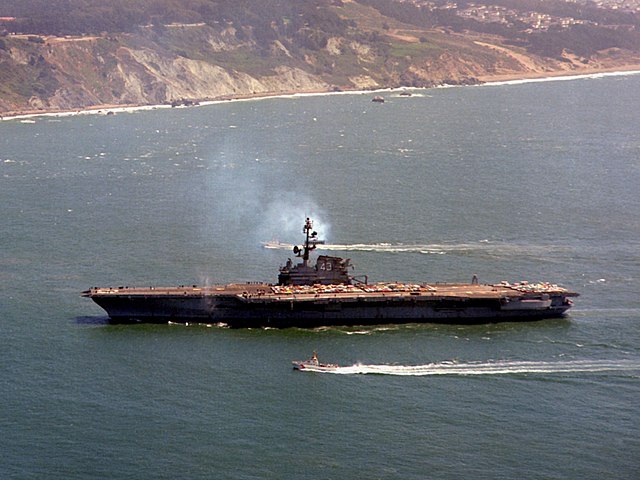
Off San Francisco Bay 1971
Just as onboard USS Constellation she was part of these ‘flattop revolts’ expanded in 1972 to Kitty Hawk, Oriskany, Ticonderoga, America, and Enterprise. This went even up to Sabotage on USS Ranger and Forrestal, aviators also voicing their concerns about the bombing campaign more openly. The Paris Peace Accords were evetually signed next year, on 23 January 1973, after four years of talks. By the spring 1975 NVA offensive however concerned the Navy, still present and USS Coral Sea, Midway, Hancock, Enterprise, and Okinawa were there on 19 April 1975, in South Vietnamese waters ready to evacuate remaining US personel and refugees On 29–30 April 1975 she participated in Operation Frequent Wind, evacuating Saigon while being anchored off Vũng Tàu.
Post-vietnam occupations
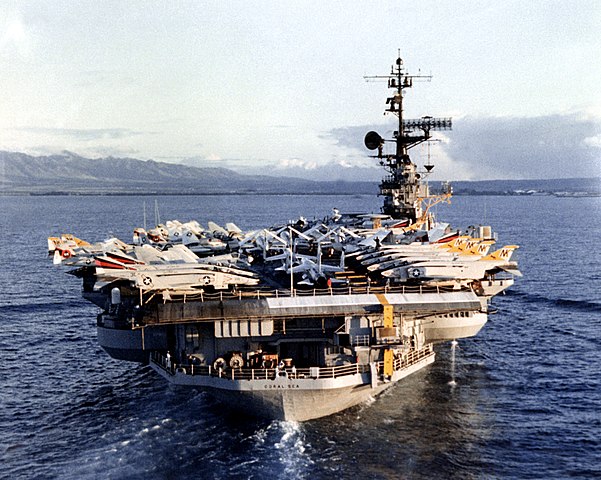
Stern view, approaching Pearl Harbor 1981
On 12-14 May 1975 USS Coral Sea was present in the Mayaguez incident, when U.S. merchant ship SS Mayaguez was forcibly seized on 12 May by Khmer Rouge gunboats. She launched striked on the Cambodian mainland and covered 288 Marines launched from U Tapao in Thailand to Koh Tang Island, rescuring the crew. USS Coral Sea earned the Meritorious Unit Commendation on 6 July 1976 now redesignated “Multi-Purpose Aircraft Carrier” or CV-43, on 30 June 1975.
1975-79 were relatively uneventful but on 4 November 1979, following the siege of the US Embassy in Tehran (hostage crisis), USS Coral Sea replaced her sister ship USS Midway in the Arabian Sea on 5 February 1980 (“Gonzo Station”) and along USS Nimitz and TF ships, she took part in Operation Evening Light, the failed rescue attempt of 24 April, as support. The crew later was awardered the Navy Expeditionary Medal. She was seen later in Subic Bay, Philippines on 9 May 1980, now under command of Captain Richard Dunleavy lated caught by the Tailhook scandal.
On 10 June 1980, she was back in Alameda, marked by a theft and court matial of two court members. She made her final WestPac on 20 August 1981, via Pearl Harbor and Subic Bay in the South China Sea. She stayed in Singapore and roamed the Indian Ocean, relieving USS America at “Gonzo Station”, also operating with the Royal Navy (Exercize GonzoEx 2-81 in November). Her own battle group was under command of Rear Admiral Tom Brown, which planned a set of complex interoparbility exercizes with RN Rear Admiral Sandy Woodward (flagship HMS Glamorgan ). The latter “sunk” Coral Sea with Exocet missiles. This weighted later in the decision to sunk the ARA Belgrano in the Falklands war.
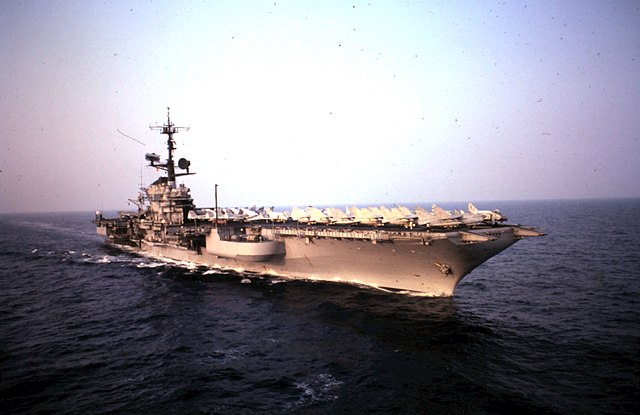
USS Coral Sea in the Mediterranean, 1983
Exercise Bright Star 82, in the defense of Egypt and the Suez Canal in early December 1981 followed ans the carrier was relieved by USS Constellation at Gonzo station, to sail to Pattaya, in Thailand, the Subic Bay, Hong Kong and Sasebo in Japan. She later made her return home via Pearl Harbor, to Alameda, arriving on 23 March 1982. It was followed by maintenance, upkeep, and exercizes off California, also “starring” in July 1982 as movie prop for “The Right Stuff”.
On 25 March 1983, she returned to the Atlantic Fleet, Norfolk. From there, she started a 6-month world cruise and was succeeded on the west coast by USS Carl Vinson. On 1 March 1984, she had a new air group, callled Carrier Air Wing 13, making three deployments until 30 September 1989. On 11 April 1985 while off Guantánamo Bay she collided with the Ecuadorian tanker ship Napo. Repairs at Norfolk took two months, and the skipper plus four officers were sacked and relieved of duty.
Mediterranean Operations: Libyan crisis
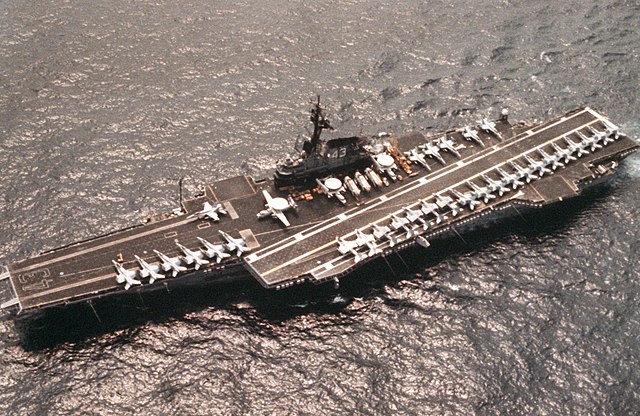
USS Coral Sea in 1986
On 13 October 1985 she was back for her “Med TOD” with the 6th under command of Captain Robert H. Ferguson, air group CVW-13, equipped with the new F/A-18 Hornet of VFA-131, VFA-132, VMFA-314 and VMFA-323. On 2 January 1986, she acquired EA-6B Prowlers (VAQ-135) for Electronic Countermeasures/Jamming Support. With this group, on 24 March 1986 she was atacked by Libyan Armed Forces missiles in the Gulf of Sidra, one being a SA-5 from Sirte was defeated by her “Blue Darter” tactic, proving the new defensive concept. Combat air patrols off the Libyan coal followed, Hornets frequently called for interceptions of incoming Libyan MiG-23s, MiG-25s, Su-22s, and Mirages.
On 5 April 1986, the carrier lost one seveiceman, several injured in the Lybian retaliatory terorist attack of a nightclub in West Berlin. On 15 April 1986, her air group combined to Coral Sea and America’s plus USAF F-111Fs from RAF Lakenheath (UK) took part in “Operation El Dorado Canyon.” against many Libyan targets, Hornets having their first combat missions. Hornets from Coral Sea destroyed the main SA-5 missile site at Sirte with AGM-88 HARM anti-radiation missile. Other SAM sites were destroyed in bad weather, without any US loss.
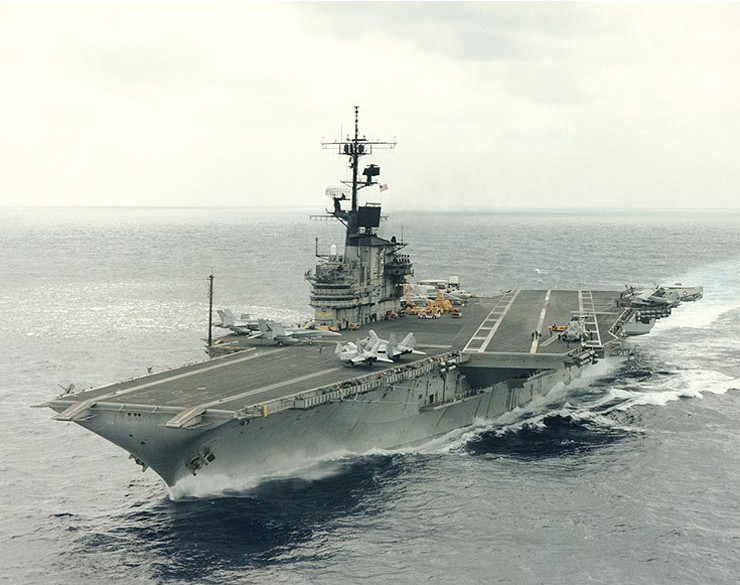
USS Coral sea making a 30 knots goodbye run before retirement, 1st March 1989
USS Coral Sea alternated between the Mediterranean and Indian Ocean for the remainder of the 1980s and in 1987 was adopted the “Coral Sea configuration” combining two attack squadrons with a shared maintenance program. On 19 April 1989 while in the Caribbean, she assisted the crippled battleship Iowa suffering a dramatic gun turret explosion. A specialized team from Coral Sea removed volatile powder charges after being transferred aboard and assisted the crew along with her surgical team, supplies, Medevac, logistical support, taxiing with Sikorsky SH-3H helicopters from HS-17. She went back to Norfolk on 30 September 1989.
By that time when the Berlin wall fell, she had 43 years of continuous service, same duration assumed for the entire cold war. After her modernization programs she was decidedly too old in her general design and decommissioned on 26 April 1990, stricken on the 28th, mothballed, and on 7 May 1993, sold for scrap. All her usable equipment was purchased and reconditioned by the Defense Reutilization and Marketing Service (DRMS). The scrapping was marred by financial, legal, and environmental issues in which the Baltimore Sun played a major part. The scrapping was over only on 8 September 2000.


 Latest Facebook Entry -
Latest Facebook Entry -  X(Tweeter) Naval Encyclopedia's deck archive
X(Tweeter) Naval Encyclopedia's deck archive Instagram (@navalencyc)
Instagram (@navalencyc)





 French Navy
French Navy Royal Navy
Royal Navy Russian Navy
Russian Navy Armada Espanola
Armada Espanola Austrian Navy
Austrian Navy K.u.K. Kriegsmarine
K.u.K. Kriegsmarine Dansk Marine
Dansk Marine Nautiko Hellenon
Nautiko Hellenon Koninklije Marine 1870
Koninklije Marine 1870 Marinha do Brasil
Marinha do Brasil Osmanlı Donanması
Osmanlı Donanması Marina Do Peru
Marina Do Peru Marinha do Portugal
Marinha do Portugal Regia Marina 1870
Regia Marina 1870 Nihhon Kaigun 1870
Nihhon Kaigun 1870 Preußische Marine 1870
Preußische Marine 1870 Russkiy Flot 1870
Russkiy Flot 1870 Svenska marinen
Svenska marinen Søværnet
Søværnet Union Navy
Union Navy Confederate Navy
Confederate Navy Armada de Argentina
Armada de Argentina Imperial Chinese Navy
Imperial Chinese Navy Marinha do Portugal
Marinha do Portugal Mexico
Mexico Kaiserliche Marine
Kaiserliche Marine 1898 US Navy
1898 US Navy Sovietskiy Flot
Sovietskiy Flot Royal Canadian Navy
Royal Canadian Navy Royal Australian Navy
Royal Australian Navy RNZN Fleet
RNZN Fleet Chinese Navy 1937
Chinese Navy 1937 Kriegsmarine
Kriegsmarine Chilean Navy
Chilean Navy Danish Navy
Danish Navy Finnish Navy
Finnish Navy Hellenic Navy
Hellenic Navy Polish Navy
Polish Navy Romanian Navy
Romanian Navy Turkish Navy
Turkish Navy Royal Yugoslav Navy
Royal Yugoslav Navy Royal Thai Navy
Royal Thai Navy Minor Navies
Minor Navies Albania
Albania Austria
Austria Belgium
Belgium Columbia
Columbia Costa Rica
Costa Rica Cuba
Cuba Czechoslovakia
Czechoslovakia Dominican Republic
Dominican Republic Haiti
Haiti Hungary
Hungary Honduras
Honduras Estonia
Estonia Iceland
Iceland Eire
Eire Equador
Equador Iran
Iran Iraq
Iraq Latvia
Latvia Liberia
Liberia Lithuania
Lithuania Mandchukuo
Mandchukuo Morocco
Morocco Nicaragua
Nicaragua Persia
Persia San Salvador
San Salvador Sarawak
Sarawak Uruguay
Uruguay Venezuela
Venezuela Zanzibar
Zanzibar Warsaw Pact Navies
Warsaw Pact Navies Bulgaria
Bulgaria Hungary
Hungary

 Bundesmarine
Bundesmarine Dutch Navy
Dutch Navy Hellenic Navy
Hellenic Navy Marina Militare
Marina Militare Yugoslav Navy
Yugoslav Navy Chinese Navy
Chinese Navy Indian Navy
Indian Navy Indonesian Navy
Indonesian Navy JMSDF
JMSDF North Korean Navy
North Korean Navy Pakistani Navy
Pakistani Navy Philippines Navy
Philippines Navy ROKN
ROKN Rep. of Singapore Navy
Rep. of Singapore Navy Taiwanese Navy
Taiwanese Navy IDF Navy
IDF Navy Saudi Navy
Saudi Navy Royal New Zealand Navy
Royal New Zealand Navy Egyptian Navy
Egyptian Navy South African Navy
South African Navy






























 Ukrainian Navy
Ukrainian Navy dbodesign
dbodesign